Team Conflict in Global Market Places
VerifiedAdded on 2022/10/10
|18
|4568
|254
AI Summary
This article discusses team conflict in global market places and its effects on organizational productivity. It covers various types of conflicts, causes, effects, and solutions to organizational conflicts. The article also highlights the role of HR in conflict resolution and recommendations. The subject covered is relevant to business and management courses. The document type is an essay and the assignment type is a research paper.
Contribute Materials
Your contribution can guide someone’s learning journey. Share your
documents today.
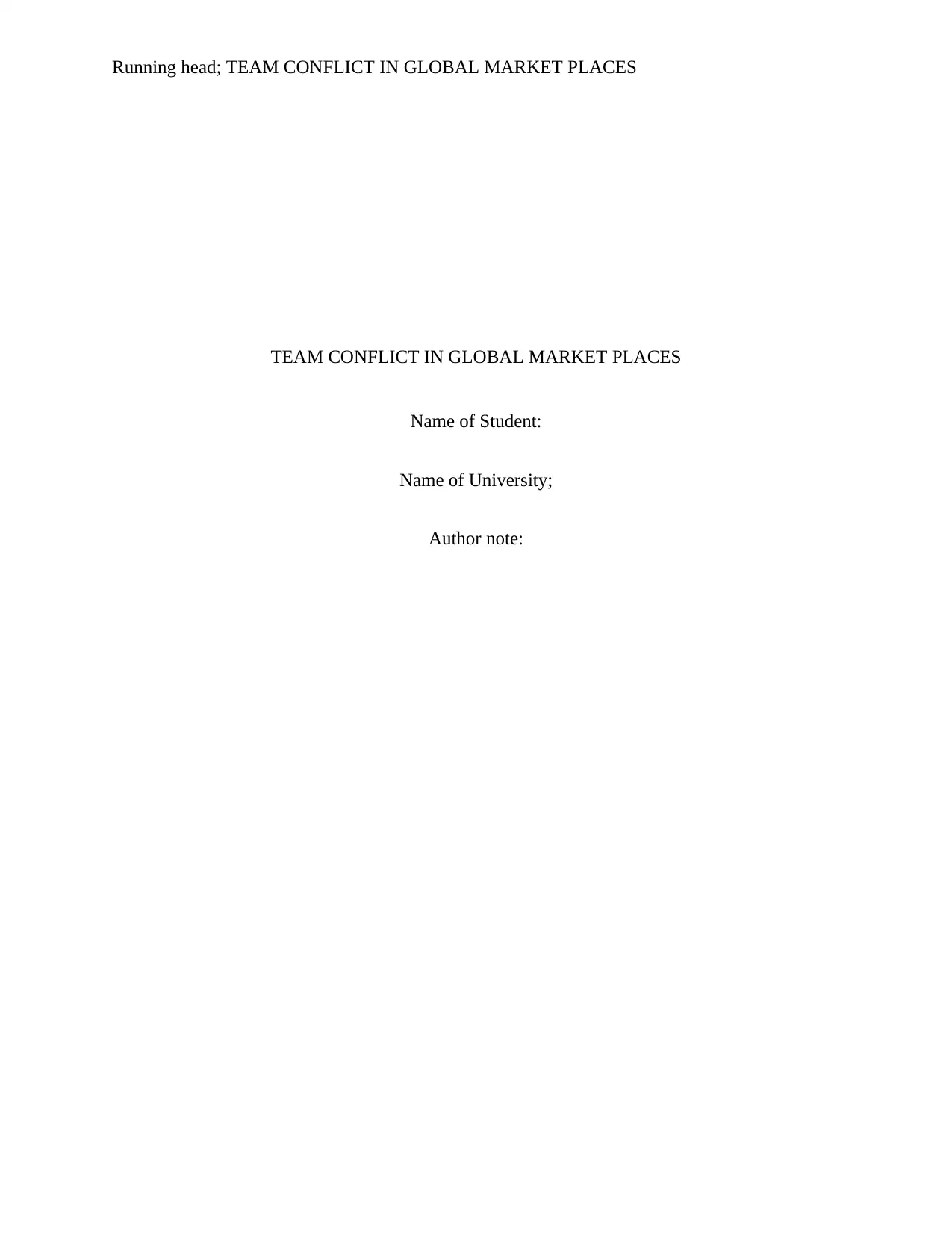
Running head; TEAM CONFLICT IN GLOBAL MARKET PLACES
TEAM CONFLICT IN GLOBAL MARKET PLACES
Name of Student:
Name of University;
Author note:
TEAM CONFLICT IN GLOBAL MARKET PLACES
Name of Student:
Name of University;
Author note:
Secure Best Marks with AI Grader
Need help grading? Try our AI Grader for instant feedback on your assignments.
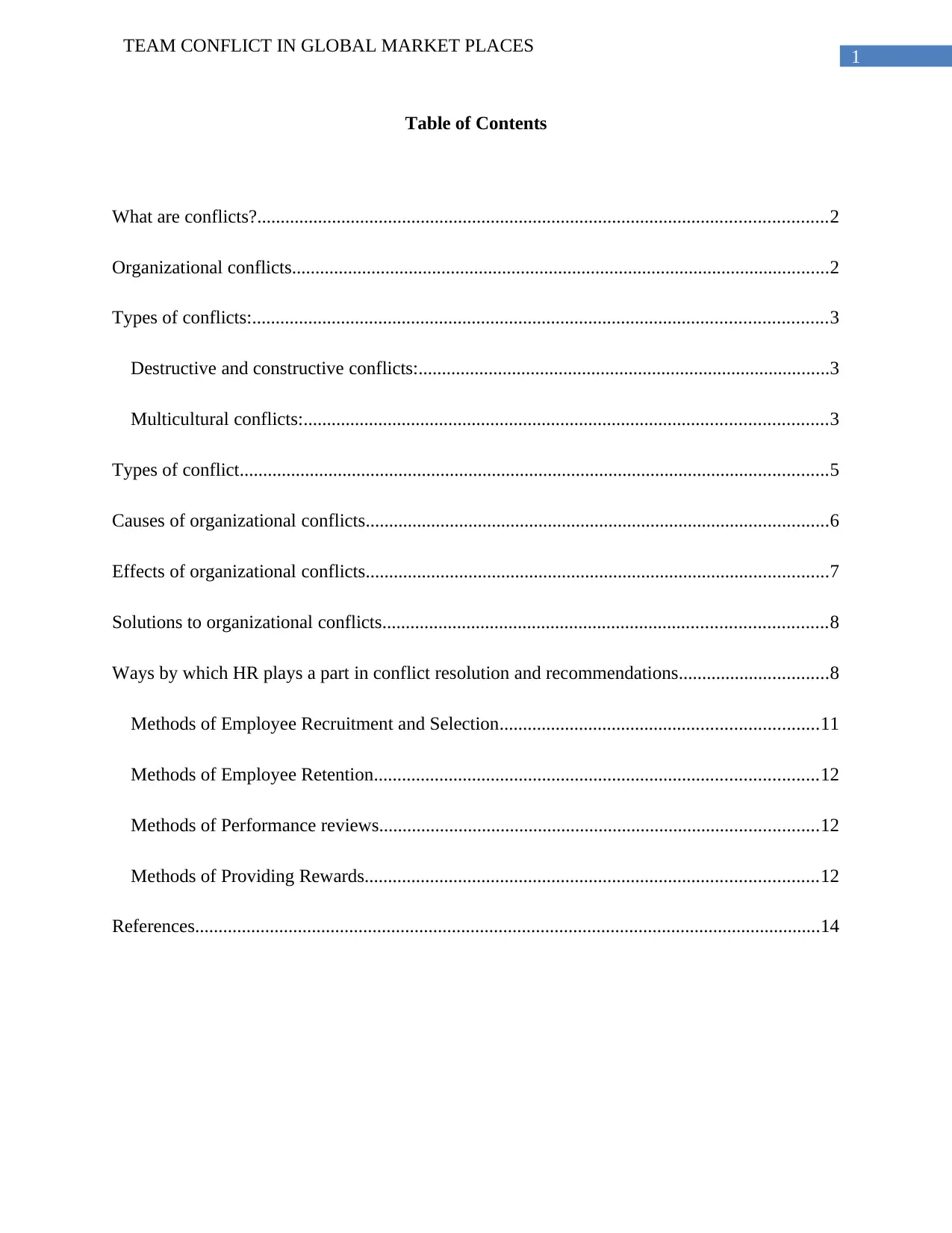
1
TEAM CONFLICT IN GLOBAL MARKET PLACES
Table of Contents
What are conflicts?..........................................................................................................................2
Organizational conflicts...................................................................................................................2
Types of conflicts:...........................................................................................................................3
Destructive and constructive conflicts:........................................................................................3
Multicultural conflicts:................................................................................................................3
Types of conflict..............................................................................................................................5
Causes of organizational conflicts...................................................................................................6
Effects of organizational conflicts...................................................................................................7
Solutions to organizational conflicts...............................................................................................8
Ways by which HR plays a part in conflict resolution and recommendations................................8
Methods of Employee Recruitment and Selection....................................................................11
Methods of Employee Retention...............................................................................................12
Methods of Performance reviews..............................................................................................12
Methods of Providing Rewards.................................................................................................12
References......................................................................................................................................14
TEAM CONFLICT IN GLOBAL MARKET PLACES
Table of Contents
What are conflicts?..........................................................................................................................2
Organizational conflicts...................................................................................................................2
Types of conflicts:...........................................................................................................................3
Destructive and constructive conflicts:........................................................................................3
Multicultural conflicts:................................................................................................................3
Types of conflict..............................................................................................................................5
Causes of organizational conflicts...................................................................................................6
Effects of organizational conflicts...................................................................................................7
Solutions to organizational conflicts...............................................................................................8
Ways by which HR plays a part in conflict resolution and recommendations................................8
Methods of Employee Recruitment and Selection....................................................................11
Methods of Employee Retention...............................................................................................12
Methods of Performance reviews..............................................................................................12
Methods of Providing Rewards.................................................................................................12
References......................................................................................................................................14
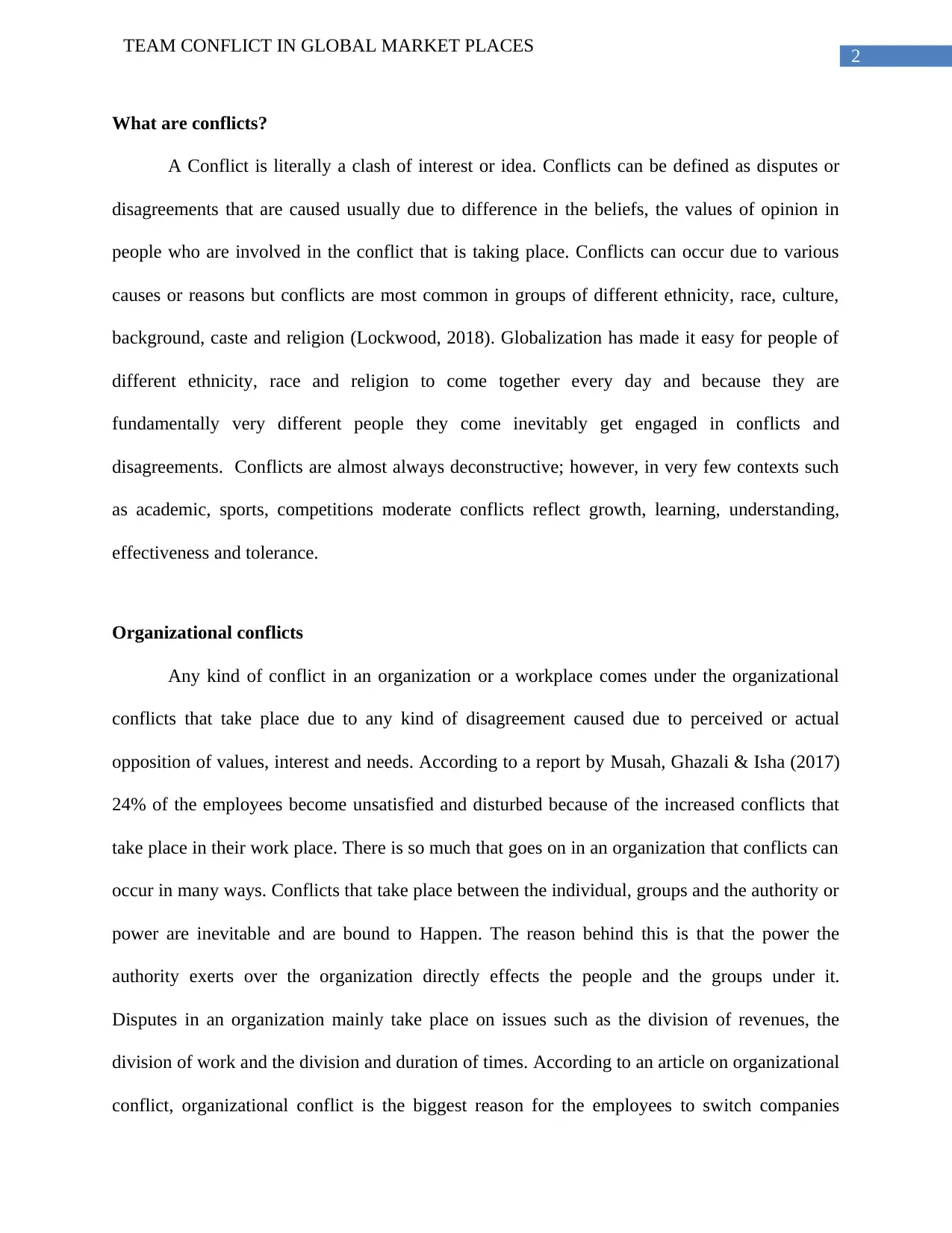
2
TEAM CONFLICT IN GLOBAL MARKET PLACES
What are conflicts?
A Conflict is literally a clash of interest or idea. Conflicts can be defined as disputes or
disagreements that are caused usually due to difference in the beliefs, the values of opinion in
people who are involved in the conflict that is taking place. Conflicts can occur due to various
causes or reasons but conflicts are most common in groups of different ethnicity, race, culture,
background, caste and religion (Lockwood, 2018). Globalization has made it easy for people of
different ethnicity, race and religion to come together every day and because they are
fundamentally very different people they come inevitably get engaged in conflicts and
disagreements. Conflicts are almost always deconstructive; however, in very few contexts such
as academic, sports, competitions moderate conflicts reflect growth, learning, understanding,
effectiveness and tolerance.
Organizational conflicts
Any kind of conflict in an organization or a workplace comes under the organizational
conflicts that take place due to any kind of disagreement caused due to perceived or actual
opposition of values, interest and needs. According to a report by Musah, Ghazali & Isha (2017)
24% of the employees become unsatisfied and disturbed because of the increased conflicts that
take place in their work place. There is so much that goes on in an organization that conflicts can
occur in many ways. Conflicts that take place between the individual, groups and the authority or
power are inevitable and are bound to Happen. The reason behind this is that the power the
authority exerts over the organization directly effects the people and the groups under it.
Disputes in an organization mainly take place on issues such as the division of revenues, the
division of work and the division and duration of times. According to an article on organizational
conflict, organizational conflict is the biggest reason for the employees to switch companies
TEAM CONFLICT IN GLOBAL MARKET PLACES
What are conflicts?
A Conflict is literally a clash of interest or idea. Conflicts can be defined as disputes or
disagreements that are caused usually due to difference in the beliefs, the values of opinion in
people who are involved in the conflict that is taking place. Conflicts can occur due to various
causes or reasons but conflicts are most common in groups of different ethnicity, race, culture,
background, caste and religion (Lockwood, 2018). Globalization has made it easy for people of
different ethnicity, race and religion to come together every day and because they are
fundamentally very different people they come inevitably get engaged in conflicts and
disagreements. Conflicts are almost always deconstructive; however, in very few contexts such
as academic, sports, competitions moderate conflicts reflect growth, learning, understanding,
effectiveness and tolerance.
Organizational conflicts
Any kind of conflict in an organization or a workplace comes under the organizational
conflicts that take place due to any kind of disagreement caused due to perceived or actual
opposition of values, interest and needs. According to a report by Musah, Ghazali & Isha (2017)
24% of the employees become unsatisfied and disturbed because of the increased conflicts that
take place in their work place. There is so much that goes on in an organization that conflicts can
occur in many ways. Conflicts that take place between the individual, groups and the authority or
power are inevitable and are bound to Happen. The reason behind this is that the power the
authority exerts over the organization directly effects the people and the groups under it.
Disputes in an organization mainly take place on issues such as the division of revenues, the
division of work and the division and duration of times. According to an article on organizational
conflict, organizational conflict is the biggest reason for the employees to switch companies
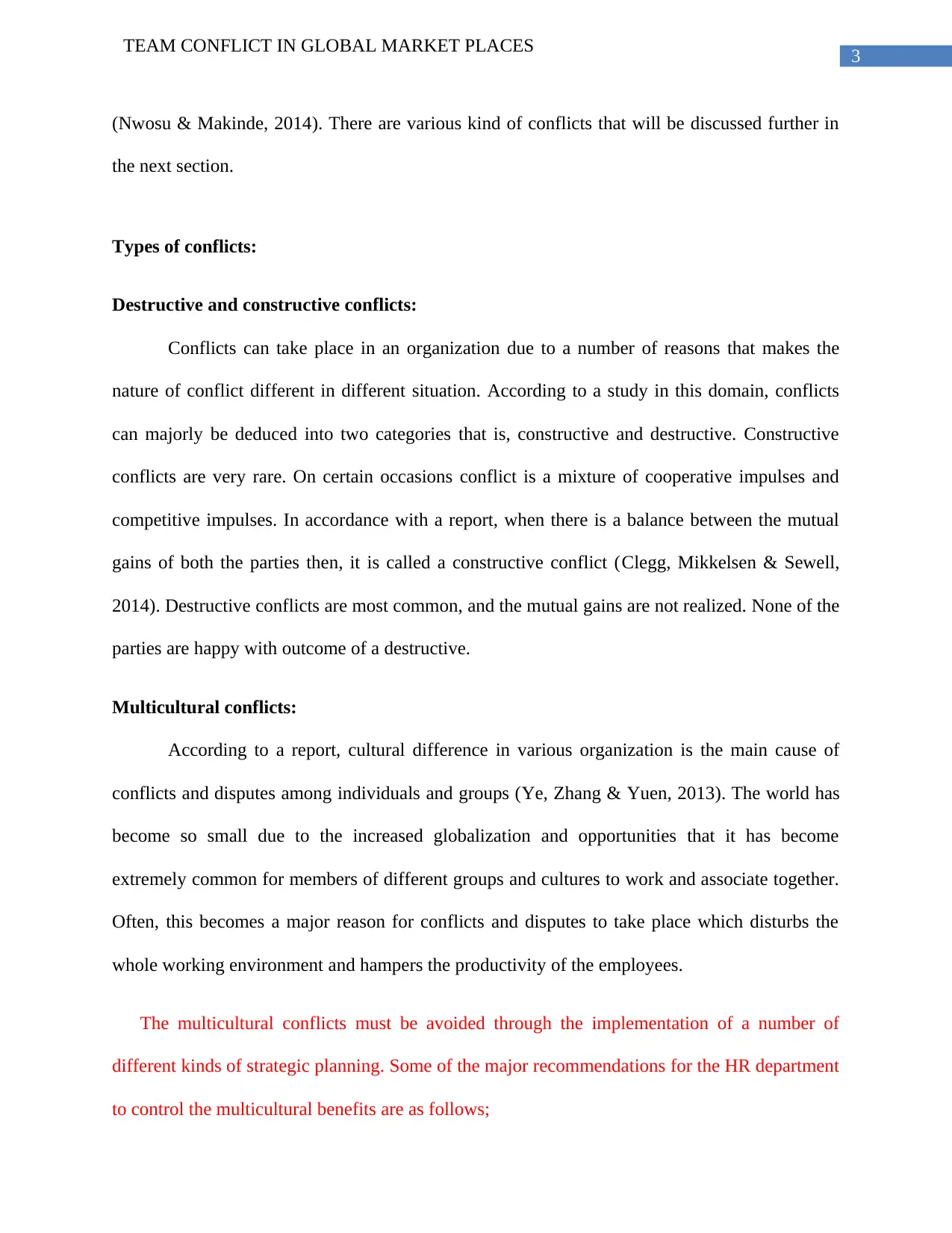
3
TEAM CONFLICT IN GLOBAL MARKET PLACES
(Nwosu & Makinde, 2014). There are various kind of conflicts that will be discussed further in
the next section.
Types of conflicts:
Destructive and constructive conflicts:
Conflicts can take place in an organization due to a number of reasons that makes the
nature of conflict different in different situation. According to a study in this domain, conflicts
can majorly be deduced into two categories that is, constructive and destructive. Constructive
conflicts are very rare. On certain occasions conflict is a mixture of cooperative impulses and
competitive impulses. In accordance with a report, when there is a balance between the mutual
gains of both the parties then, it is called a constructive conflict (Clegg, Mikkelsen & Sewell,
2014). Destructive conflicts are most common, and the mutual gains are not realized. None of the
parties are happy with outcome of a destructive.
Multicultural conflicts:
According to a report, cultural difference in various organization is the main cause of
conflicts and disputes among individuals and groups (Ye, Zhang & Yuen, 2013). The world has
become so small due to the increased globalization and opportunities that it has become
extremely common for members of different groups and cultures to work and associate together.
Often, this becomes a major reason for conflicts and disputes to take place which disturbs the
whole working environment and hampers the productivity of the employees.
The multicultural conflicts must be avoided through the implementation of a number of
different kinds of strategic planning. Some of the major recommendations for the HR department
to control the multicultural benefits are as follows;
TEAM CONFLICT IN GLOBAL MARKET PLACES
(Nwosu & Makinde, 2014). There are various kind of conflicts that will be discussed further in
the next section.
Types of conflicts:
Destructive and constructive conflicts:
Conflicts can take place in an organization due to a number of reasons that makes the
nature of conflict different in different situation. According to a study in this domain, conflicts
can majorly be deduced into two categories that is, constructive and destructive. Constructive
conflicts are very rare. On certain occasions conflict is a mixture of cooperative impulses and
competitive impulses. In accordance with a report, when there is a balance between the mutual
gains of both the parties then, it is called a constructive conflict (Clegg, Mikkelsen & Sewell,
2014). Destructive conflicts are most common, and the mutual gains are not realized. None of the
parties are happy with outcome of a destructive.
Multicultural conflicts:
According to a report, cultural difference in various organization is the main cause of
conflicts and disputes among individuals and groups (Ye, Zhang & Yuen, 2013). The world has
become so small due to the increased globalization and opportunities that it has become
extremely common for members of different groups and cultures to work and associate together.
Often, this becomes a major reason for conflicts and disputes to take place which disturbs the
whole working environment and hampers the productivity of the employees.
The multicultural conflicts must be avoided through the implementation of a number of
different kinds of strategic planning. Some of the major recommendations for the HR department
to control the multicultural benefits are as follows;
Secure Best Marks with AI Grader
Need help grading? Try our AI Grader for instant feedback on your assignments.
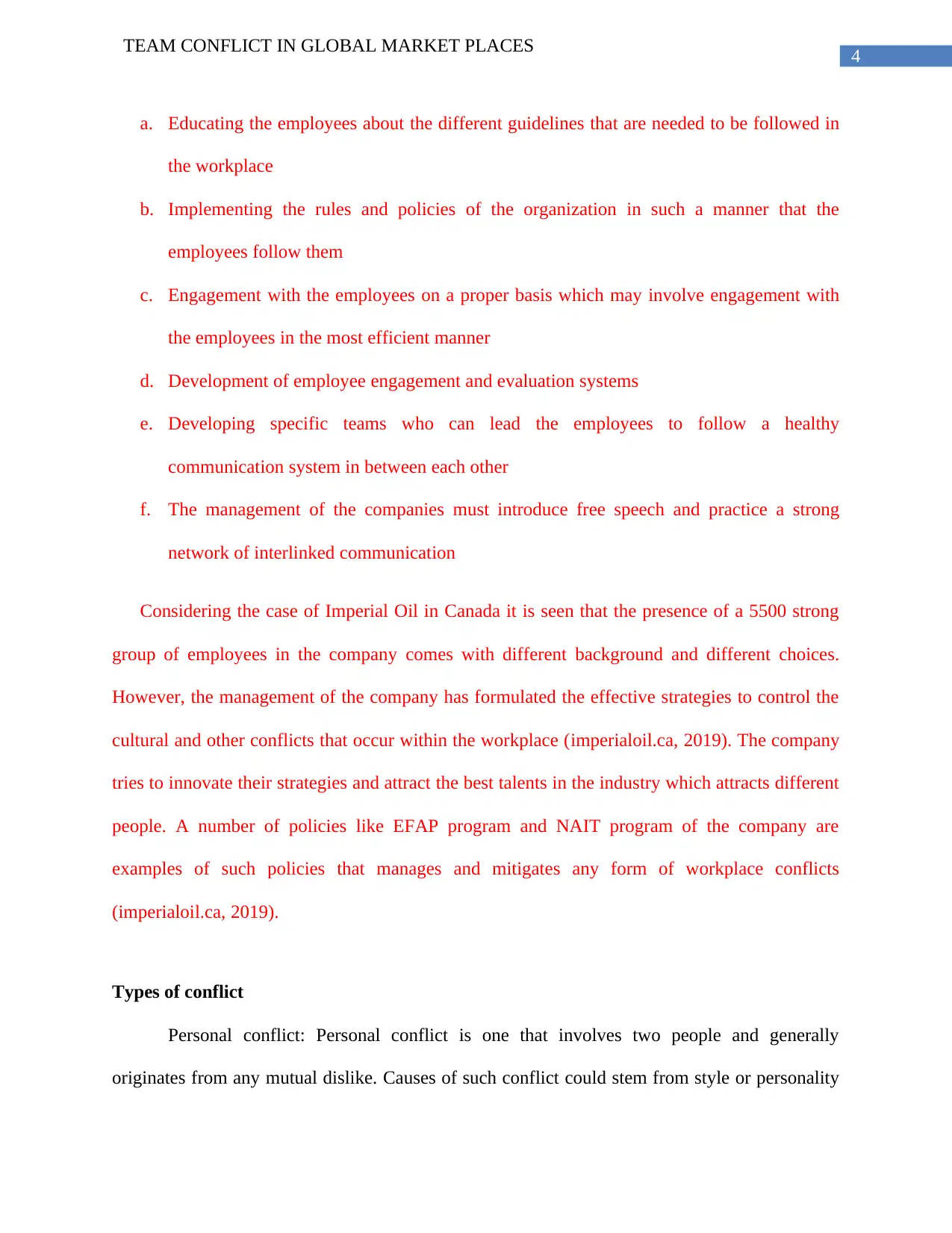
4
TEAM CONFLICT IN GLOBAL MARKET PLACES
a. Educating the employees about the different guidelines that are needed to be followed in
the workplace
b. Implementing the rules and policies of the organization in such a manner that the
employees follow them
c. Engagement with the employees on a proper basis which may involve engagement with
the employees in the most efficient manner
d. Development of employee engagement and evaluation systems
e. Developing specific teams who can lead the employees to follow a healthy
communication system in between each other
f. The management of the companies must introduce free speech and practice a strong
network of interlinked communication
Considering the case of Imperial Oil in Canada it is seen that the presence of a 5500 strong
group of employees in the company comes with different background and different choices.
However, the management of the company has formulated the effective strategies to control the
cultural and other conflicts that occur within the workplace (imperialoil.ca, 2019). The company
tries to innovate their strategies and attract the best talents in the industry which attracts different
people. A number of policies like EFAP program and NAIT program of the company are
examples of such policies that manages and mitigates any form of workplace conflicts
(imperialoil.ca, 2019).
Types of conflict
Personal conflict: Personal conflict is one that involves two people and generally
originates from any mutual dislike. Causes of such conflict could stem from style or personality
TEAM CONFLICT IN GLOBAL MARKET PLACES
a. Educating the employees about the different guidelines that are needed to be followed in
the workplace
b. Implementing the rules and policies of the organization in such a manner that the
employees follow them
c. Engagement with the employees on a proper basis which may involve engagement with
the employees in the most efficient manner
d. Development of employee engagement and evaluation systems
e. Developing specific teams who can lead the employees to follow a healthy
communication system in between each other
f. The management of the companies must introduce free speech and practice a strong
network of interlinked communication
Considering the case of Imperial Oil in Canada it is seen that the presence of a 5500 strong
group of employees in the company comes with different background and different choices.
However, the management of the company has formulated the effective strategies to control the
cultural and other conflicts that occur within the workplace (imperialoil.ca, 2019). The company
tries to innovate their strategies and attract the best talents in the industry which attracts different
people. A number of policies like EFAP program and NAIT program of the company are
examples of such policies that manages and mitigates any form of workplace conflicts
(imperialoil.ca, 2019).
Types of conflict
Personal conflict: Personal conflict is one that involves two people and generally
originates from any mutual dislike. Causes of such conflict could stem from style or personality
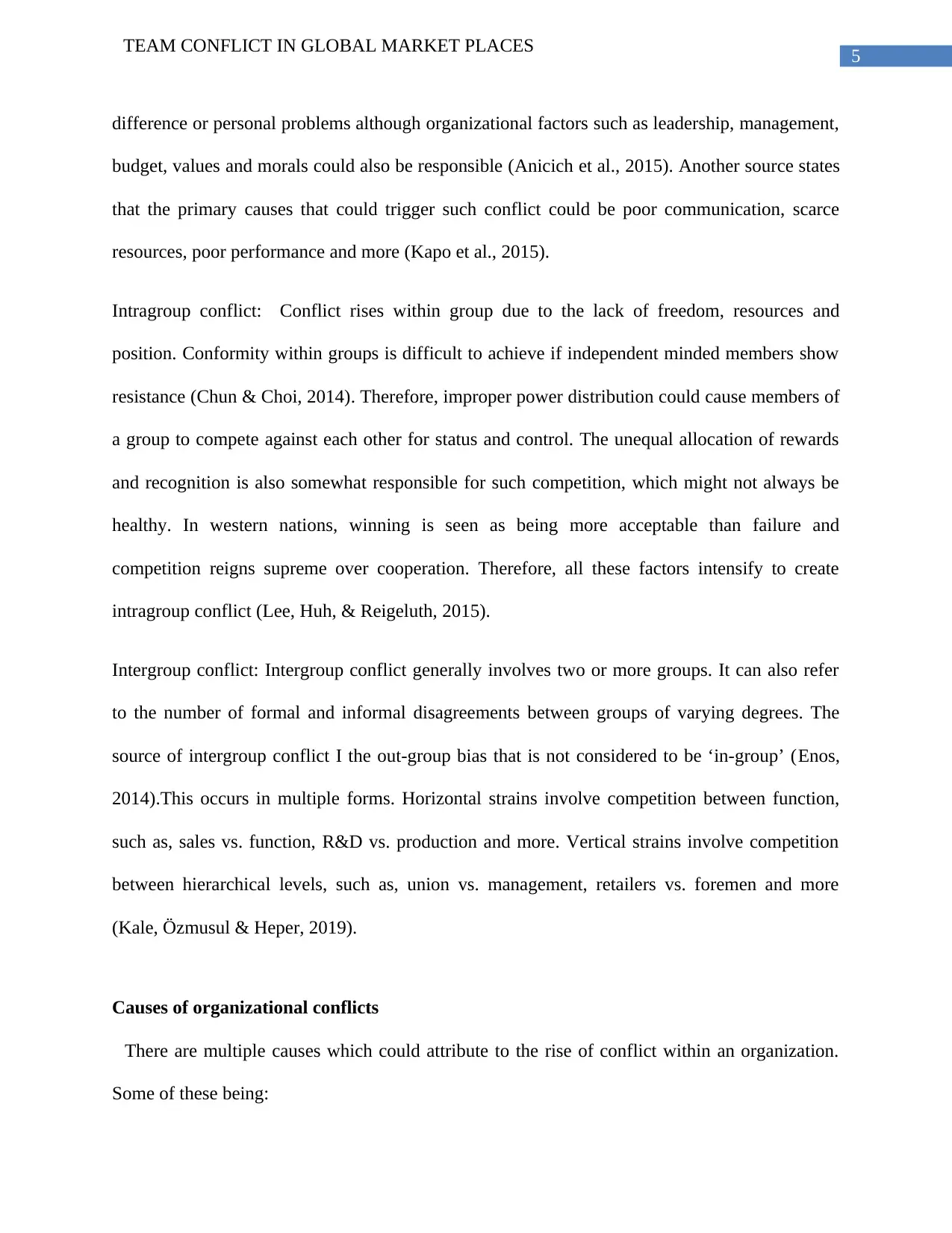
5
TEAM CONFLICT IN GLOBAL MARKET PLACES
difference or personal problems although organizational factors such as leadership, management,
budget, values and morals could also be responsible (Anicich et al., 2015). Another source states
that the primary causes that could trigger such conflict could be poor communication, scarce
resources, poor performance and more (Kapo et al., 2015).
Intragroup conflict: Conflict rises within group due to the lack of freedom, resources and
position. Conformity within groups is difficult to achieve if independent minded members show
resistance (Chun & Choi, 2014). Therefore, improper power distribution could cause members of
a group to compete against each other for status and control. The unequal allocation of rewards
and recognition is also somewhat responsible for such competition, which might not always be
healthy. In western nations, winning is seen as being more acceptable than failure and
competition reigns supreme over cooperation. Therefore, all these factors intensify to create
intragroup conflict (Lee, Huh, & Reigeluth, 2015).
Intergroup conflict: Intergroup conflict generally involves two or more groups. It can also refer
to the number of formal and informal disagreements between groups of varying degrees. The
source of intergroup conflict I the out-group bias that is not considered to be ‘in-group’ (Enos,
2014).This occurs in multiple forms. Horizontal strains involve competition between function,
such as, sales vs. function, R&D vs. production and more. Vertical strains involve competition
between hierarchical levels, such as, union vs. management, retailers vs. foremen and more
(Kale, Özmusul & Heper, 2019).
Causes of organizational conflicts
There are multiple causes which could attribute to the rise of conflict within an organization.
Some of these being:
TEAM CONFLICT IN GLOBAL MARKET PLACES
difference or personal problems although organizational factors such as leadership, management,
budget, values and morals could also be responsible (Anicich et al., 2015). Another source states
that the primary causes that could trigger such conflict could be poor communication, scarce
resources, poor performance and more (Kapo et al., 2015).
Intragroup conflict: Conflict rises within group due to the lack of freedom, resources and
position. Conformity within groups is difficult to achieve if independent minded members show
resistance (Chun & Choi, 2014). Therefore, improper power distribution could cause members of
a group to compete against each other for status and control. The unequal allocation of rewards
and recognition is also somewhat responsible for such competition, which might not always be
healthy. In western nations, winning is seen as being more acceptable than failure and
competition reigns supreme over cooperation. Therefore, all these factors intensify to create
intragroup conflict (Lee, Huh, & Reigeluth, 2015).
Intergroup conflict: Intergroup conflict generally involves two or more groups. It can also refer
to the number of formal and informal disagreements between groups of varying degrees. The
source of intergroup conflict I the out-group bias that is not considered to be ‘in-group’ (Enos,
2014).This occurs in multiple forms. Horizontal strains involve competition between function,
such as, sales vs. function, R&D vs. production and more. Vertical strains involve competition
between hierarchical levels, such as, union vs. management, retailers vs. foremen and more
(Kale, Özmusul & Heper, 2019).
Causes of organizational conflicts
There are multiple causes which could attribute to the rise of conflict within an organization.
Some of these being:
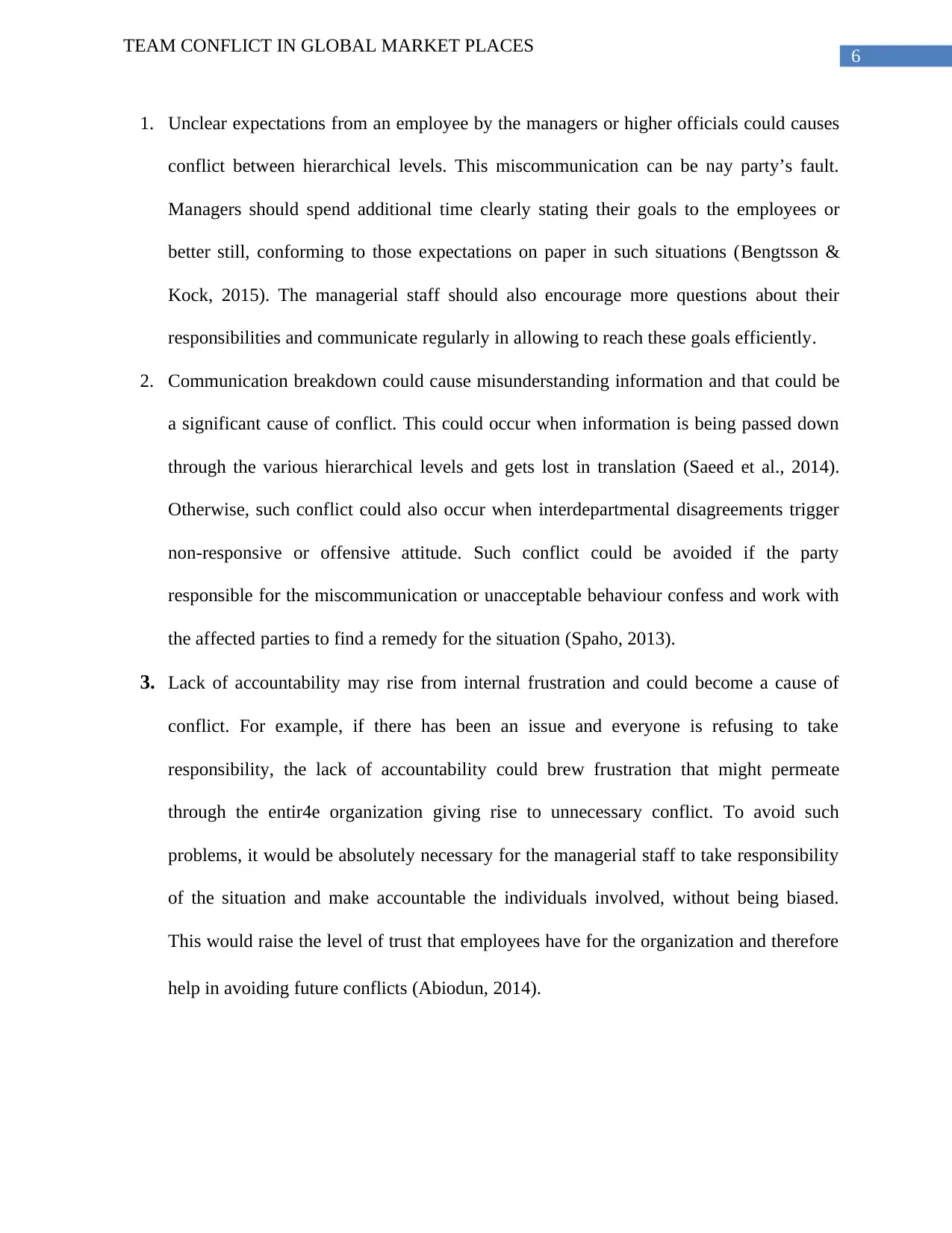
6
TEAM CONFLICT IN GLOBAL MARKET PLACES
1. Unclear expectations from an employee by the managers or higher officials could causes
conflict between hierarchical levels. This miscommunication can be nay party’s fault.
Managers should spend additional time clearly stating their goals to the employees or
better still, conforming to those expectations on paper in such situations (Bengtsson &
Kock, 2015). The managerial staff should also encourage more questions about their
responsibilities and communicate regularly in allowing to reach these goals efficiently.
2. Communication breakdown could cause misunderstanding information and that could be
a significant cause of conflict. This could occur when information is being passed down
through the various hierarchical levels and gets lost in translation (Saeed et al., 2014).
Otherwise, such conflict could also occur when interdepartmental disagreements trigger
non-responsive or offensive attitude. Such conflict could be avoided if the party
responsible for the miscommunication or unacceptable behaviour confess and work with
the affected parties to find a remedy for the situation (Spaho, 2013).
3. Lack of accountability may rise from internal frustration and could become a cause of
conflict. For example, if there has been an issue and everyone is refusing to take
responsibility, the lack of accountability could brew frustration that might permeate
through the entir4e organization giving rise to unnecessary conflict. To avoid such
problems, it would be absolutely necessary for the managerial staff to take responsibility
of the situation and make accountable the individuals involved, without being biased.
This would raise the level of trust that employees have for the organization and therefore
help in avoiding future conflicts (Abiodun, 2014).
TEAM CONFLICT IN GLOBAL MARKET PLACES
1. Unclear expectations from an employee by the managers or higher officials could causes
conflict between hierarchical levels. This miscommunication can be nay party’s fault.
Managers should spend additional time clearly stating their goals to the employees or
better still, conforming to those expectations on paper in such situations (Bengtsson &
Kock, 2015). The managerial staff should also encourage more questions about their
responsibilities and communicate regularly in allowing to reach these goals efficiently.
2. Communication breakdown could cause misunderstanding information and that could be
a significant cause of conflict. This could occur when information is being passed down
through the various hierarchical levels and gets lost in translation (Saeed et al., 2014).
Otherwise, such conflict could also occur when interdepartmental disagreements trigger
non-responsive or offensive attitude. Such conflict could be avoided if the party
responsible for the miscommunication or unacceptable behaviour confess and work with
the affected parties to find a remedy for the situation (Spaho, 2013).
3. Lack of accountability may rise from internal frustration and could become a cause of
conflict. For example, if there has been an issue and everyone is refusing to take
responsibility, the lack of accountability could brew frustration that might permeate
through the entir4e organization giving rise to unnecessary conflict. To avoid such
problems, it would be absolutely necessary for the managerial staff to take responsibility
of the situation and make accountable the individuals involved, without being biased.
This would raise the level of trust that employees have for the organization and therefore
help in avoiding future conflicts (Abiodun, 2014).
Paraphrase This Document
Need a fresh take? Get an instant paraphrase of this document with our AI Paraphraser
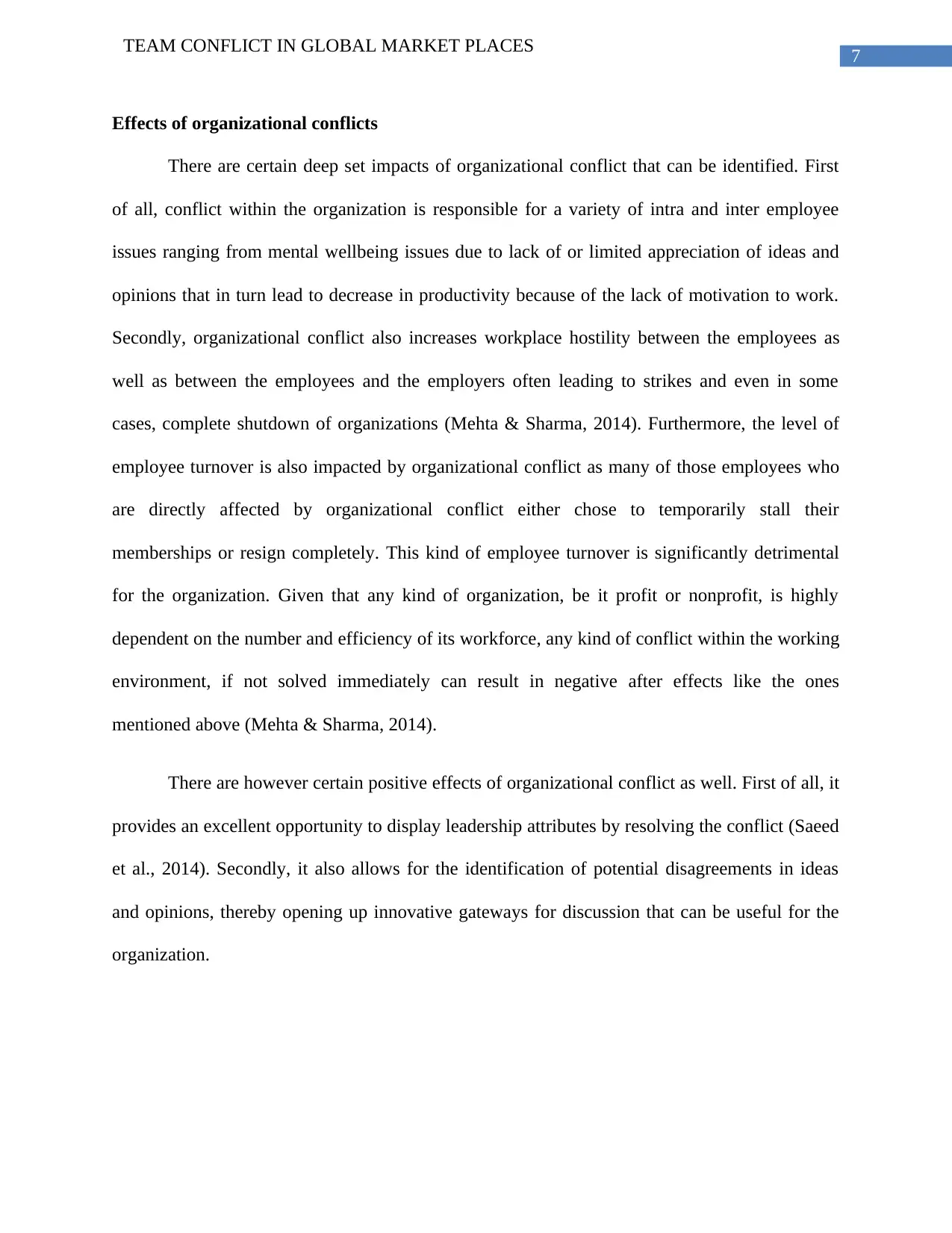
7
TEAM CONFLICT IN GLOBAL MARKET PLACES
Effects of organizational conflicts
There are certain deep set impacts of organizational conflict that can be identified. First
of all, conflict within the organization is responsible for a variety of intra and inter employee
issues ranging from mental wellbeing issues due to lack of or limited appreciation of ideas and
opinions that in turn lead to decrease in productivity because of the lack of motivation to work.
Secondly, organizational conflict also increases workplace hostility between the employees as
well as between the employees and the employers often leading to strikes and even in some
cases, complete shutdown of organizations (Mehta & Sharma, 2014). Furthermore, the level of
employee turnover is also impacted by organizational conflict as many of those employees who
are directly affected by organizational conflict either chose to temporarily stall their
memberships or resign completely. This kind of employee turnover is significantly detrimental
for the organization. Given that any kind of organization, be it profit or nonprofit, is highly
dependent on the number and efficiency of its workforce, any kind of conflict within the working
environment, if not solved immediately can result in negative after effects like the ones
mentioned above (Mehta & Sharma, 2014).
There are however certain positive effects of organizational conflict as well. First of all, it
provides an excellent opportunity to display leadership attributes by resolving the conflict (Saeed
et al., 2014). Secondly, it also allows for the identification of potential disagreements in ideas
and opinions, thereby opening up innovative gateways for discussion that can be useful for the
organization.
TEAM CONFLICT IN GLOBAL MARKET PLACES
Effects of organizational conflicts
There are certain deep set impacts of organizational conflict that can be identified. First
of all, conflict within the organization is responsible for a variety of intra and inter employee
issues ranging from mental wellbeing issues due to lack of or limited appreciation of ideas and
opinions that in turn lead to decrease in productivity because of the lack of motivation to work.
Secondly, organizational conflict also increases workplace hostility between the employees as
well as between the employees and the employers often leading to strikes and even in some
cases, complete shutdown of organizations (Mehta & Sharma, 2014). Furthermore, the level of
employee turnover is also impacted by organizational conflict as many of those employees who
are directly affected by organizational conflict either chose to temporarily stall their
memberships or resign completely. This kind of employee turnover is significantly detrimental
for the organization. Given that any kind of organization, be it profit or nonprofit, is highly
dependent on the number and efficiency of its workforce, any kind of conflict within the working
environment, if not solved immediately can result in negative after effects like the ones
mentioned above (Mehta & Sharma, 2014).
There are however certain positive effects of organizational conflict as well. First of all, it
provides an excellent opportunity to display leadership attributes by resolving the conflict (Saeed
et al., 2014). Secondly, it also allows for the identification of potential disagreements in ideas
and opinions, thereby opening up innovative gateways for discussion that can be useful for the
organization.
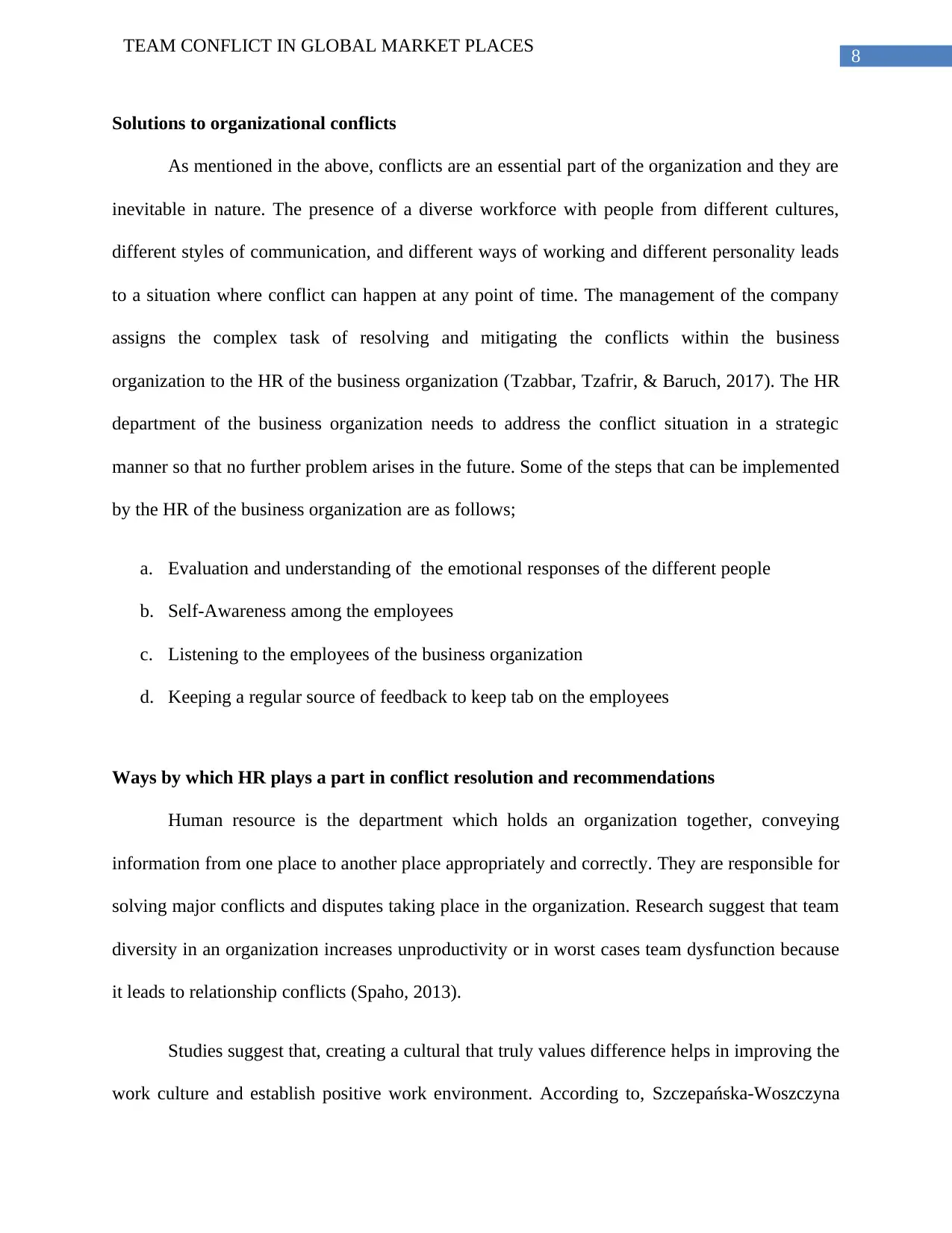
8
TEAM CONFLICT IN GLOBAL MARKET PLACES
Solutions to organizational conflicts
As mentioned in the above, conflicts are an essential part of the organization and they are
inevitable in nature. The presence of a diverse workforce with people from different cultures,
different styles of communication, and different ways of working and different personality leads
to a situation where conflict can happen at any point of time. The management of the company
assigns the complex task of resolving and mitigating the conflicts within the business
organization to the HR of the business organization (Tzabbar, Tzafrir, & Baruch, 2017). The HR
department of the business organization needs to address the conflict situation in a strategic
manner so that no further problem arises in the future. Some of the steps that can be implemented
by the HR of the business organization are as follows;
a. Evaluation and understanding of the emotional responses of the different people
b. Self-Awareness among the employees
c. Listening to the employees of the business organization
d. Keeping a regular source of feedback to keep tab on the employees
Ways by which HR plays a part in conflict resolution and recommendations
Human resource is the department which holds an organization together, conveying
information from one place to another place appropriately and correctly. They are responsible for
solving major conflicts and disputes taking place in the organization. Research suggest that team
diversity in an organization increases unproductivity or in worst cases team dysfunction because
it leads to relationship conflicts (Spaho, 2013).
Studies suggest that, creating a cultural that truly values difference helps in improving the
work culture and establish positive work environment. According to, Szczepańska-Woszczyna
TEAM CONFLICT IN GLOBAL MARKET PLACES
Solutions to organizational conflicts
As mentioned in the above, conflicts are an essential part of the organization and they are
inevitable in nature. The presence of a diverse workforce with people from different cultures,
different styles of communication, and different ways of working and different personality leads
to a situation where conflict can happen at any point of time. The management of the company
assigns the complex task of resolving and mitigating the conflicts within the business
organization to the HR of the business organization (Tzabbar, Tzafrir, & Baruch, 2017). The HR
department of the business organization needs to address the conflict situation in a strategic
manner so that no further problem arises in the future. Some of the steps that can be implemented
by the HR of the business organization are as follows;
a. Evaluation and understanding of the emotional responses of the different people
b. Self-Awareness among the employees
c. Listening to the employees of the business organization
d. Keeping a regular source of feedback to keep tab on the employees
Ways by which HR plays a part in conflict resolution and recommendations
Human resource is the department which holds an organization together, conveying
information from one place to another place appropriately and correctly. They are responsible for
solving major conflicts and disputes taking place in the organization. Research suggest that team
diversity in an organization increases unproductivity or in worst cases team dysfunction because
it leads to relationship conflicts (Spaho, 2013).
Studies suggest that, creating a cultural that truly values difference helps in improving the
work culture and establish positive work environment. According to, Szczepańska-Woszczyna
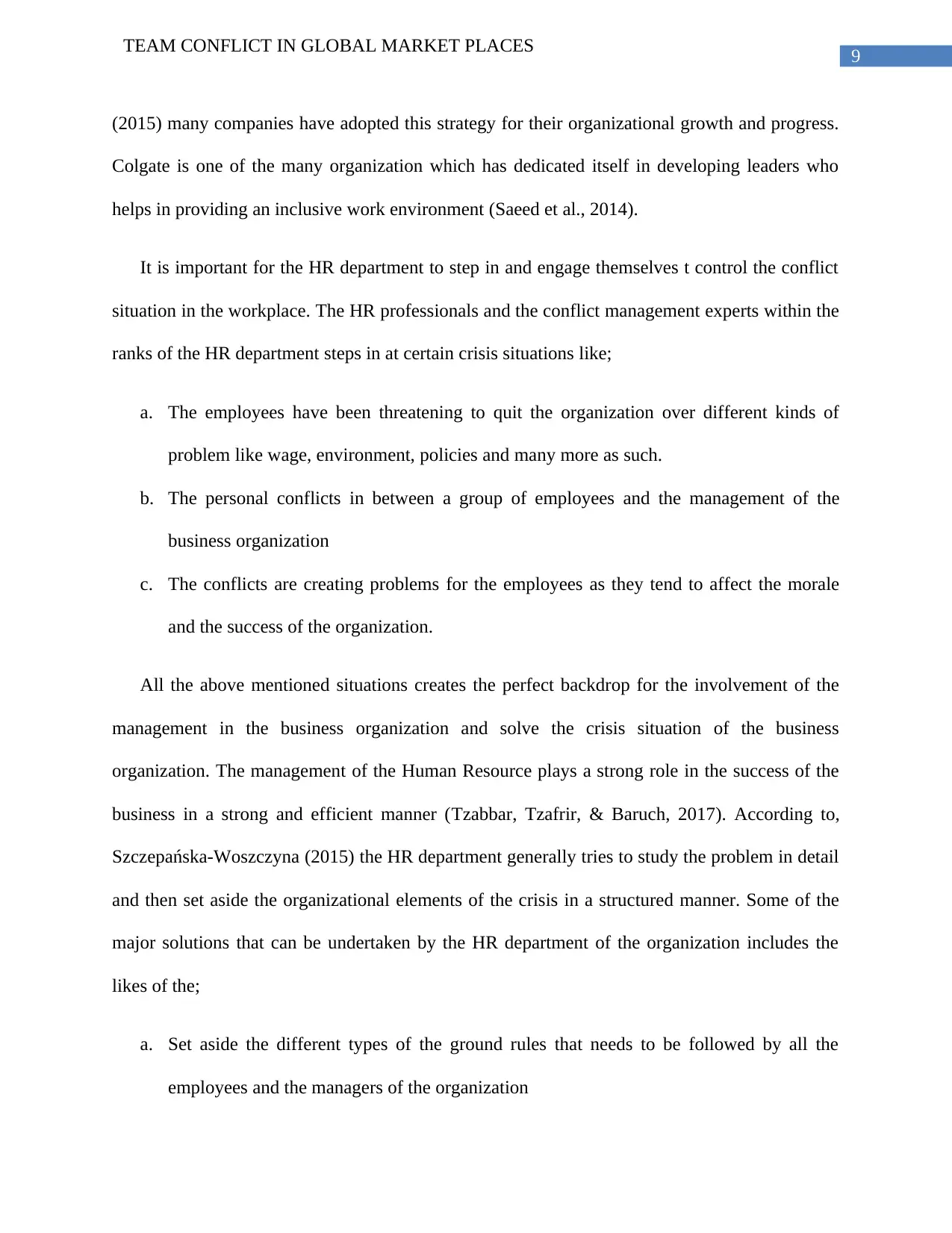
9
TEAM CONFLICT IN GLOBAL MARKET PLACES
(2015) many companies have adopted this strategy for their organizational growth and progress.
Colgate is one of the many organization which has dedicated itself in developing leaders who
helps in providing an inclusive work environment (Saeed et al., 2014).
It is important for the HR department to step in and engage themselves t control the conflict
situation in the workplace. The HR professionals and the conflict management experts within the
ranks of the HR department steps in at certain crisis situations like;
a. The employees have been threatening to quit the organization over different kinds of
problem like wage, environment, policies and many more as such.
b. The personal conflicts in between a group of employees and the management of the
business organization
c. The conflicts are creating problems for the employees as they tend to affect the morale
and the success of the organization.
All the above mentioned situations creates the perfect backdrop for the involvement of the
management in the business organization and solve the crisis situation of the business
organization. The management of the Human Resource plays a strong role in the success of the
business in a strong and efficient manner (Tzabbar, Tzafrir, & Baruch, 2017). According to,
Szczepańska-Woszczyna (2015) the HR department generally tries to study the problem in detail
and then set aside the organizational elements of the crisis in a structured manner. Some of the
major solutions that can be undertaken by the HR department of the organization includes the
likes of the;
a. Set aside the different types of the ground rules that needs to be followed by all the
employees and the managers of the organization
TEAM CONFLICT IN GLOBAL MARKET PLACES
(2015) many companies have adopted this strategy for their organizational growth and progress.
Colgate is one of the many organization which has dedicated itself in developing leaders who
helps in providing an inclusive work environment (Saeed et al., 2014).
It is important for the HR department to step in and engage themselves t control the conflict
situation in the workplace. The HR professionals and the conflict management experts within the
ranks of the HR department steps in at certain crisis situations like;
a. The employees have been threatening to quit the organization over different kinds of
problem like wage, environment, policies and many more as such.
b. The personal conflicts in between a group of employees and the management of the
business organization
c. The conflicts are creating problems for the employees as they tend to affect the morale
and the success of the organization.
All the above mentioned situations creates the perfect backdrop for the involvement of the
management in the business organization and solve the crisis situation of the business
organization. The management of the Human Resource plays a strong role in the success of the
business in a strong and efficient manner (Tzabbar, Tzafrir, & Baruch, 2017). According to,
Szczepańska-Woszczyna (2015) the HR department generally tries to study the problem in detail
and then set aside the organizational elements of the crisis in a structured manner. Some of the
major solutions that can be undertaken by the HR department of the organization includes the
likes of the;
a. Set aside the different types of the ground rules that needs to be followed by all the
employees and the managers of the organization
Secure Best Marks with AI Grader
Need help grading? Try our AI Grader for instant feedback on your assignments.
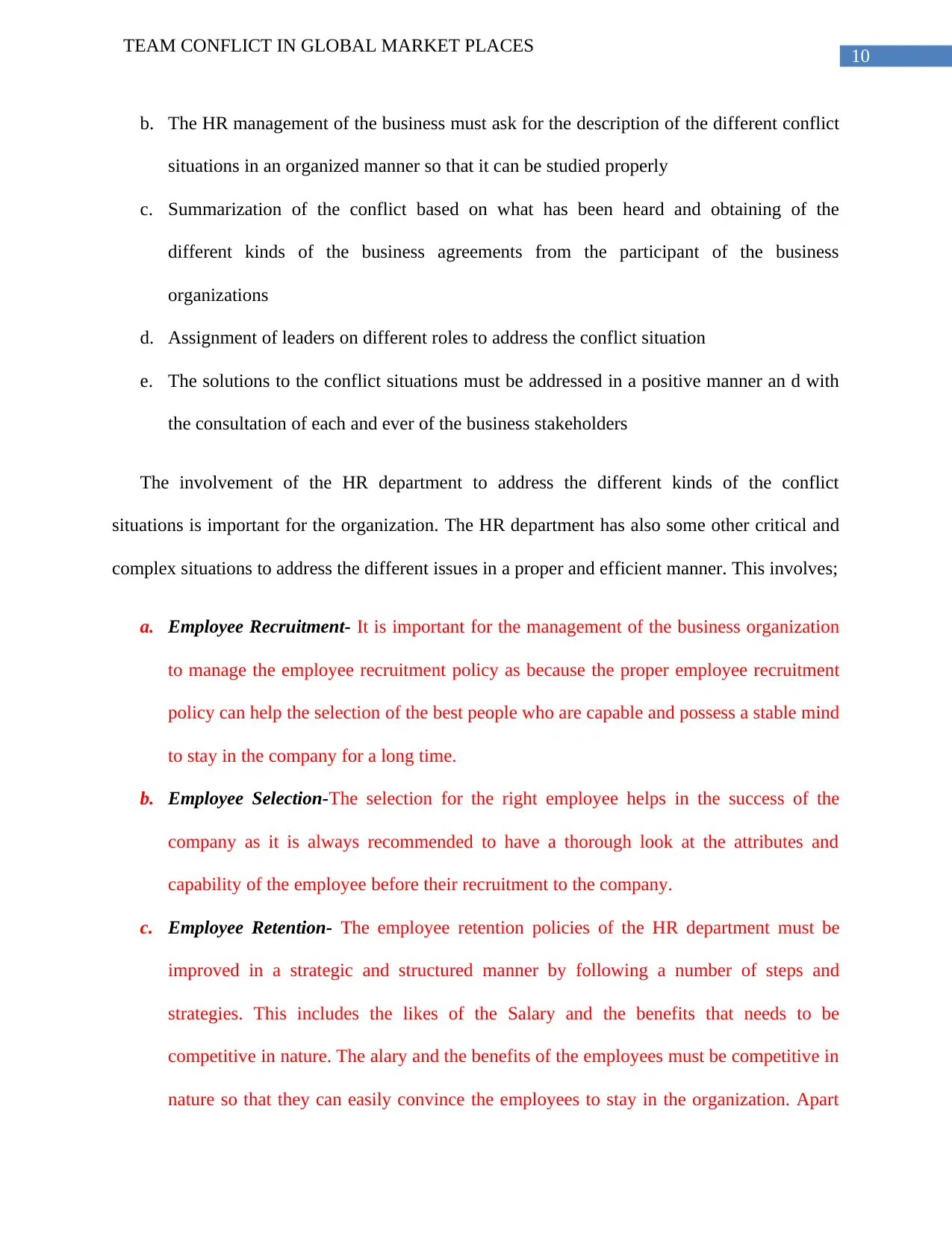
10
TEAM CONFLICT IN GLOBAL MARKET PLACES
b. The HR management of the business must ask for the description of the different conflict
situations in an organized manner so that it can be studied properly
c. Summarization of the conflict based on what has been heard and obtaining of the
different kinds of the business agreements from the participant of the business
organizations
d. Assignment of leaders on different roles to address the conflict situation
e. The solutions to the conflict situations must be addressed in a positive manner an d with
the consultation of each and ever of the business stakeholders
The involvement of the HR department to address the different kinds of the conflict
situations is important for the organization. The HR department has also some other critical and
complex situations to address the different issues in a proper and efficient manner. This involves;
a. Employee Recruitment- It is important for the management of the business organization
to manage the employee recruitment policy as because the proper employee recruitment
policy can help the selection of the best people who are capable and possess a stable mind
to stay in the company for a long time.
b. Employee Selection-The selection for the right employee helps in the success of the
company as it is always recommended to have a thorough look at the attributes and
capability of the employee before their recruitment to the company.
c. Employee Retention- The employee retention policies of the HR department must be
improved in a strategic and structured manner by following a number of steps and
strategies. This includes the likes of the Salary and the benefits that needs to be
competitive in nature. The alary and the benefits of the employees must be competitive in
nature so that they can easily convince the employees to stay in the organization. Apart
TEAM CONFLICT IN GLOBAL MARKET PLACES
b. The HR management of the business must ask for the description of the different conflict
situations in an organized manner so that it can be studied properly
c. Summarization of the conflict based on what has been heard and obtaining of the
different kinds of the business agreements from the participant of the business
organizations
d. Assignment of leaders on different roles to address the conflict situation
e. The solutions to the conflict situations must be addressed in a positive manner an d with
the consultation of each and ever of the business stakeholders
The involvement of the HR department to address the different kinds of the conflict
situations is important for the organization. The HR department has also some other critical and
complex situations to address the different issues in a proper and efficient manner. This involves;
a. Employee Recruitment- It is important for the management of the business organization
to manage the employee recruitment policy as because the proper employee recruitment
policy can help the selection of the best people who are capable and possess a stable mind
to stay in the company for a long time.
b. Employee Selection-The selection for the right employee helps in the success of the
company as it is always recommended to have a thorough look at the attributes and
capability of the employee before their recruitment to the company.
c. Employee Retention- The employee retention policies of the HR department must be
improved in a strategic and structured manner by following a number of steps and
strategies. This includes the likes of the Salary and the benefits that needs to be
competitive in nature. The alary and the benefits of the employees must be competitive in
nature so that they can easily convince the employees to stay in the organization. Apart
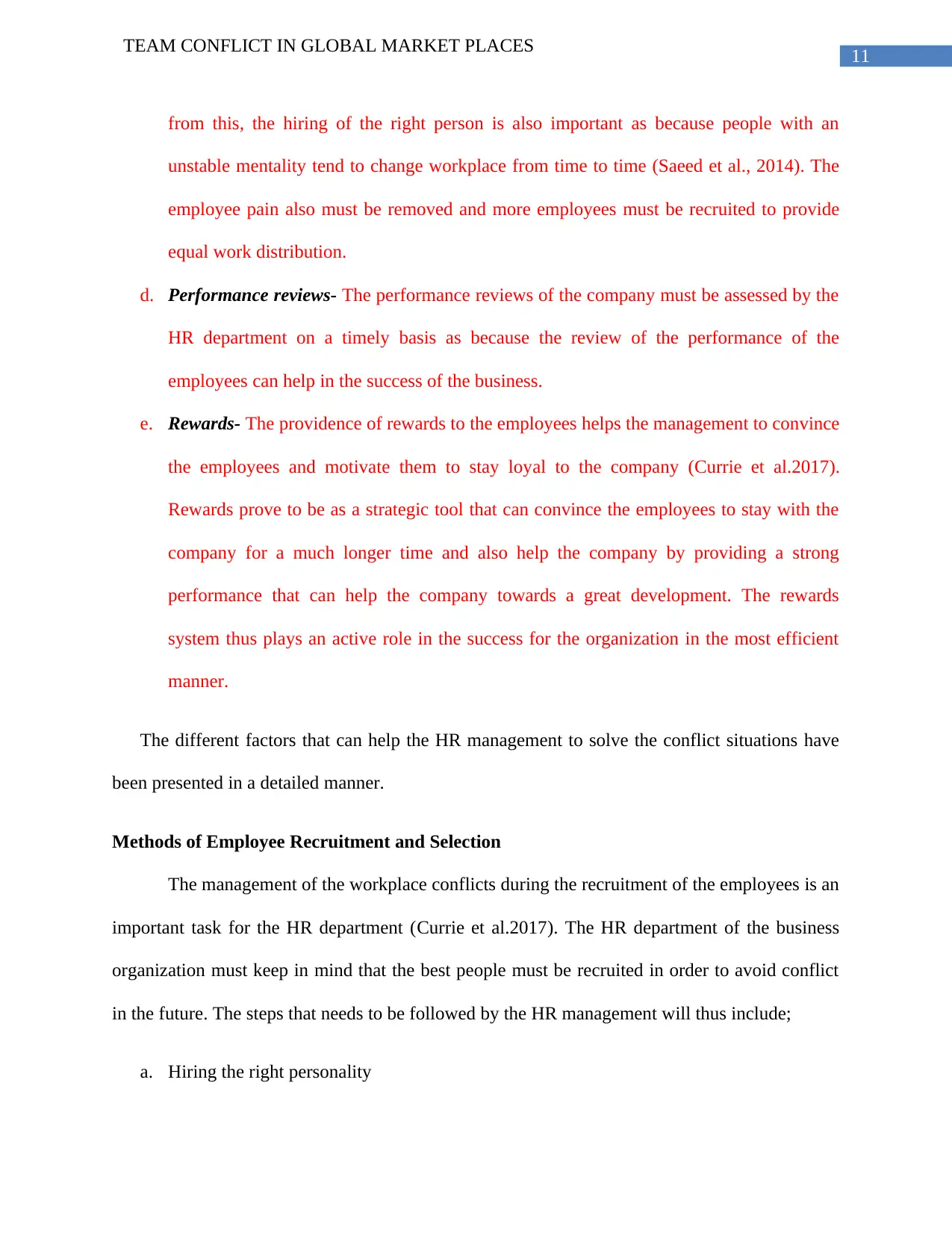
11
TEAM CONFLICT IN GLOBAL MARKET PLACES
from this, the hiring of the right person is also important as because people with an
unstable mentality tend to change workplace from time to time (Saeed et al., 2014). The
employee pain also must be removed and more employees must be recruited to provide
equal work distribution.
d. Performance reviews- The performance reviews of the company must be assessed by the
HR department on a timely basis as because the review of the performance of the
employees can help in the success of the business.
e. Rewards- The providence of rewards to the employees helps the management to convince
the employees and motivate them to stay loyal to the company (Currie et al.2017).
Rewards prove to be as a strategic tool that can convince the employees to stay with the
company for a much longer time and also help the company by providing a strong
performance that can help the company towards a great development. The rewards
system thus plays an active role in the success for the organization in the most efficient
manner.
The different factors that can help the HR management to solve the conflict situations have
been presented in a detailed manner.
Methods of Employee Recruitment and Selection
The management of the workplace conflicts during the recruitment of the employees is an
important task for the HR department (Currie et al.2017). The HR department of the business
organization must keep in mind that the best people must be recruited in order to avoid conflict
in the future. The steps that needs to be followed by the HR management will thus include;
a. Hiring the right personality
TEAM CONFLICT IN GLOBAL MARKET PLACES
from this, the hiring of the right person is also important as because people with an
unstable mentality tend to change workplace from time to time (Saeed et al., 2014). The
employee pain also must be removed and more employees must be recruited to provide
equal work distribution.
d. Performance reviews- The performance reviews of the company must be assessed by the
HR department on a timely basis as because the review of the performance of the
employees can help in the success of the business.
e. Rewards- The providence of rewards to the employees helps the management to convince
the employees and motivate them to stay loyal to the company (Currie et al.2017).
Rewards prove to be as a strategic tool that can convince the employees to stay with the
company for a much longer time and also help the company by providing a strong
performance that can help the company towards a great development. The rewards
system thus plays an active role in the success for the organization in the most efficient
manner.
The different factors that can help the HR management to solve the conflict situations have
been presented in a detailed manner.
Methods of Employee Recruitment and Selection
The management of the workplace conflicts during the recruitment of the employees is an
important task for the HR department (Currie et al.2017). The HR department of the business
organization must keep in mind that the best people must be recruited in order to avoid conflict
in the future. The steps that needs to be followed by the HR management will thus include;
a. Hiring the right personality
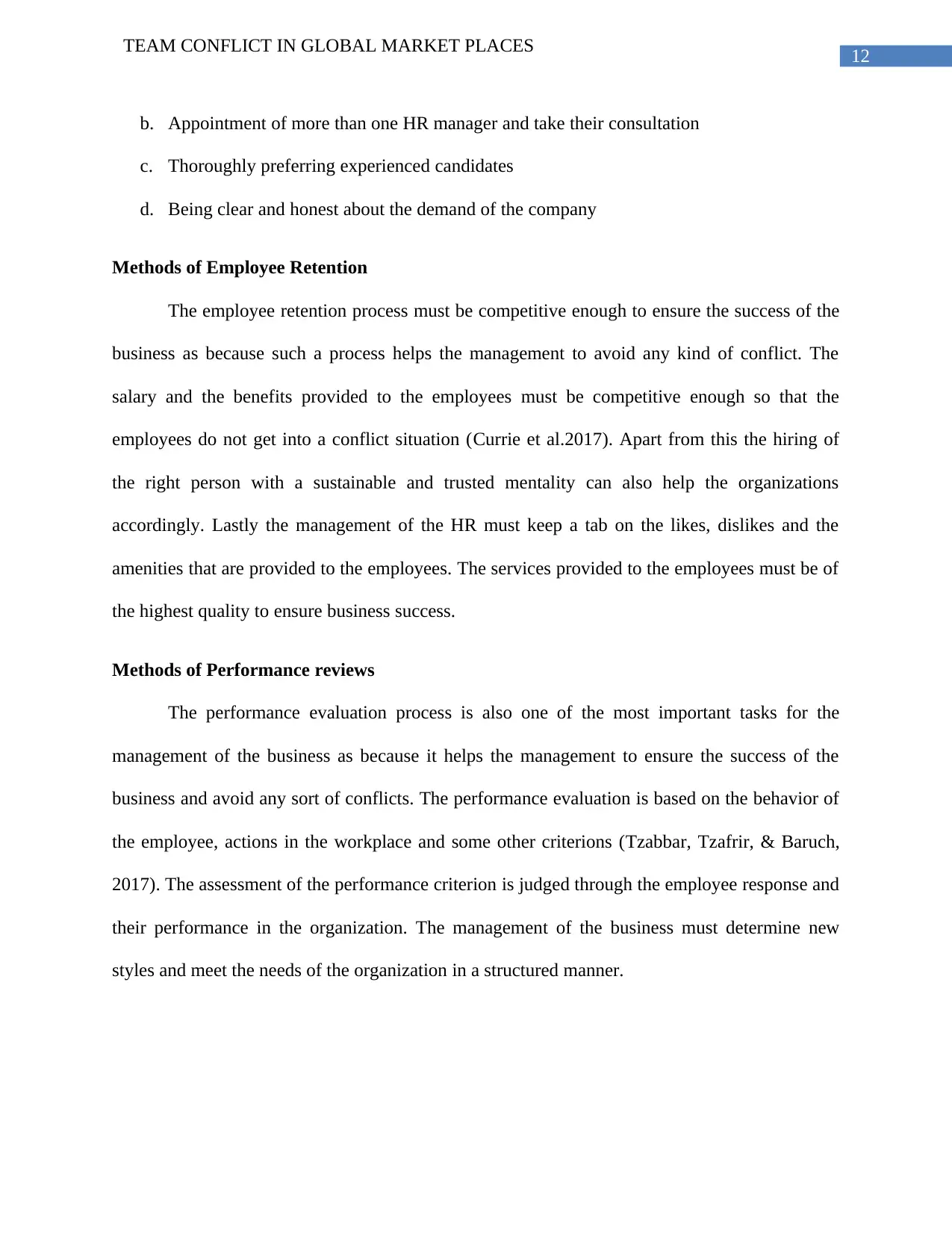
12
TEAM CONFLICT IN GLOBAL MARKET PLACES
b. Appointment of more than one HR manager and take their consultation
c. Thoroughly preferring experienced candidates
d. Being clear and honest about the demand of the company
Methods of Employee Retention
The employee retention process must be competitive enough to ensure the success of the
business as because such a process helps the management to avoid any kind of conflict. The
salary and the benefits provided to the employees must be competitive enough so that the
employees do not get into a conflict situation (Currie et al.2017). Apart from this the hiring of
the right person with a sustainable and trusted mentality can also help the organizations
accordingly. Lastly the management of the HR must keep a tab on the likes, dislikes and the
amenities that are provided to the employees. The services provided to the employees must be of
the highest quality to ensure business success.
Methods of Performance reviews
The performance evaluation process is also one of the most important tasks for the
management of the business as because it helps the management to ensure the success of the
business and avoid any sort of conflicts. The performance evaluation is based on the behavior of
the employee, actions in the workplace and some other criterions (Tzabbar, Tzafrir, & Baruch,
2017). The assessment of the performance criterion is judged through the employee response and
their performance in the organization. The management of the business must determine new
styles and meet the needs of the organization in a structured manner.
TEAM CONFLICT IN GLOBAL MARKET PLACES
b. Appointment of more than one HR manager and take their consultation
c. Thoroughly preferring experienced candidates
d. Being clear and honest about the demand of the company
Methods of Employee Retention
The employee retention process must be competitive enough to ensure the success of the
business as because such a process helps the management to avoid any kind of conflict. The
salary and the benefits provided to the employees must be competitive enough so that the
employees do not get into a conflict situation (Currie et al.2017). Apart from this the hiring of
the right person with a sustainable and trusted mentality can also help the organizations
accordingly. Lastly the management of the HR must keep a tab on the likes, dislikes and the
amenities that are provided to the employees. The services provided to the employees must be of
the highest quality to ensure business success.
Methods of Performance reviews
The performance evaluation process is also one of the most important tasks for the
management of the business as because it helps the management to ensure the success of the
business and avoid any sort of conflicts. The performance evaluation is based on the behavior of
the employee, actions in the workplace and some other criterions (Tzabbar, Tzafrir, & Baruch,
2017). The assessment of the performance criterion is judged through the employee response and
their performance in the organization. The management of the business must determine new
styles and meet the needs of the organization in a structured manner.
Paraphrase This Document
Need a fresh take? Get an instant paraphrase of this document with our AI Paraphraser
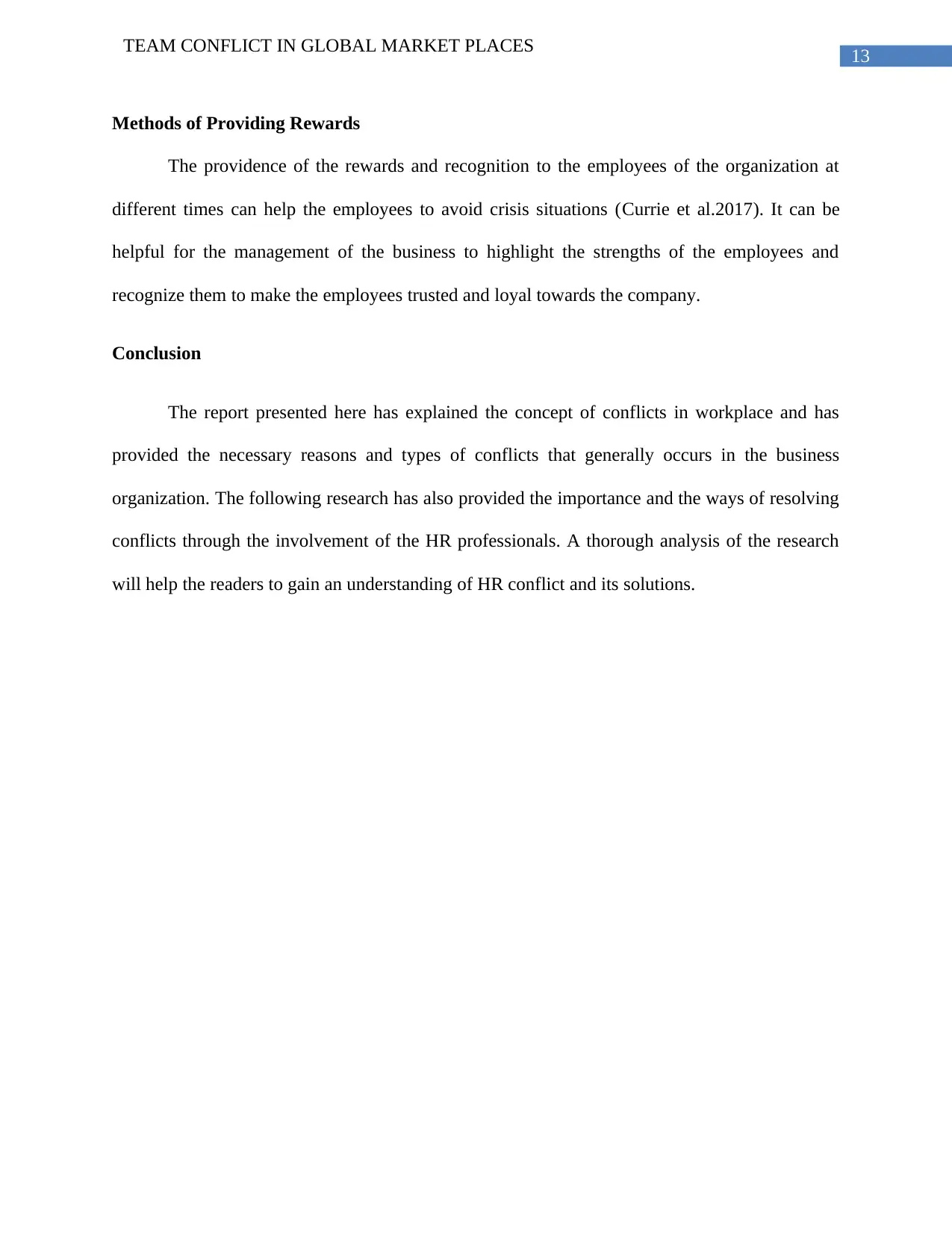
13
TEAM CONFLICT IN GLOBAL MARKET PLACES
Methods of Providing Rewards
The providence of the rewards and recognition to the employees of the organization at
different times can help the employees to avoid crisis situations (Currie et al.2017). It can be
helpful for the management of the business to highlight the strengths of the employees and
recognize them to make the employees trusted and loyal towards the company.
Conclusion
The report presented here has explained the concept of conflicts in workplace and has
provided the necessary reasons and types of conflicts that generally occurs in the business
organization. The following research has also provided the importance and the ways of resolving
conflicts through the involvement of the HR professionals. A thorough analysis of the research
will help the readers to gain an understanding of HR conflict and its solutions.
TEAM CONFLICT IN GLOBAL MARKET PLACES
Methods of Providing Rewards
The providence of the rewards and recognition to the employees of the organization at
different times can help the employees to avoid crisis situations (Currie et al.2017). It can be
helpful for the management of the business to highlight the strengths of the employees and
recognize them to make the employees trusted and loyal towards the company.
Conclusion
The report presented here has explained the concept of conflicts in workplace and has
provided the necessary reasons and types of conflicts that generally occurs in the business
organization. The following research has also provided the importance and the ways of resolving
conflicts through the involvement of the HR professionals. A thorough analysis of the research
will help the readers to gain an understanding of HR conflict and its solutions.
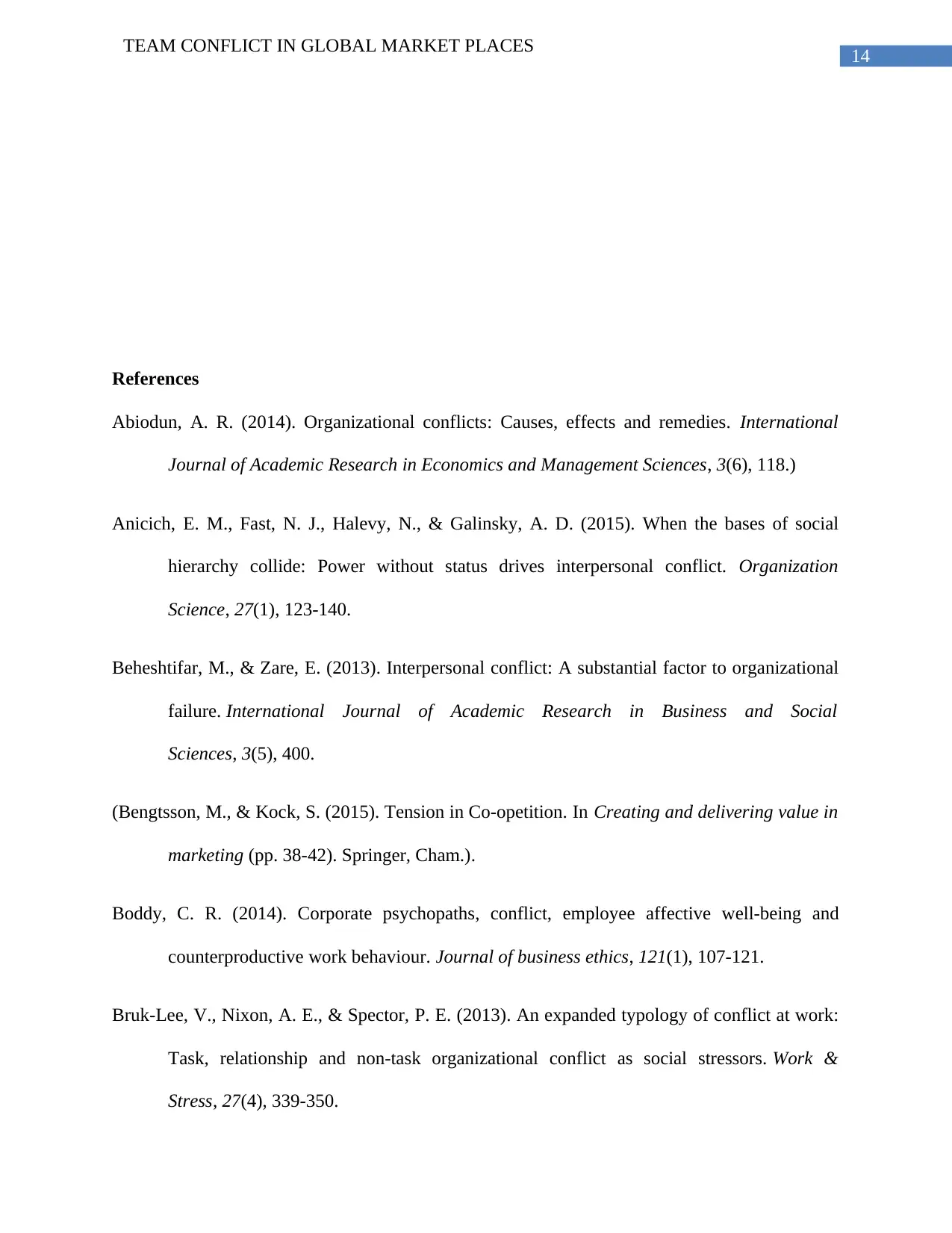
14
TEAM CONFLICT IN GLOBAL MARKET PLACES
References
Abiodun, A. R. (2014). Organizational conflicts: Causes, effects and remedies. International
Journal of Academic Research in Economics and Management Sciences, 3(6), 118.)
Anicich, E. M., Fast, N. J., Halevy, N., & Galinsky, A. D. (2015). When the bases of social
hierarchy collide: Power without status drives interpersonal conflict. Organization
Science, 27(1), 123-140.
Beheshtifar, M., & Zare, E. (2013). Interpersonal conflict: A substantial factor to organizational
failure. International Journal of Academic Research in Business and Social
Sciences, 3(5), 400.
(Bengtsson, M., & Kock, S. (2015). Tension in Co-opetition. In Creating and delivering value in
marketing (pp. 38-42). Springer, Cham.).
Boddy, C. R. (2014). Corporate psychopaths, conflict, employee affective well-being and
counterproductive work behaviour. Journal of business ethics, 121(1), 107-121.
Bruk-Lee, V., Nixon, A. E., & Spector, P. E. (2013). An expanded typology of conflict at work:
Task, relationship and non-task organizational conflict as social stressors. Work &
Stress, 27(4), 339-350.
TEAM CONFLICT IN GLOBAL MARKET PLACES
References
Abiodun, A. R. (2014). Organizational conflicts: Causes, effects and remedies. International
Journal of Academic Research in Economics and Management Sciences, 3(6), 118.)
Anicich, E. M., Fast, N. J., Halevy, N., & Galinsky, A. D. (2015). When the bases of social
hierarchy collide: Power without status drives interpersonal conflict. Organization
Science, 27(1), 123-140.
Beheshtifar, M., & Zare, E. (2013). Interpersonal conflict: A substantial factor to organizational
failure. International Journal of Academic Research in Business and Social
Sciences, 3(5), 400.
(Bengtsson, M., & Kock, S. (2015). Tension in Co-opetition. In Creating and delivering value in
marketing (pp. 38-42). Springer, Cham.).
Boddy, C. R. (2014). Corporate psychopaths, conflict, employee affective well-being and
counterproductive work behaviour. Journal of business ethics, 121(1), 107-121.
Bruk-Lee, V., Nixon, A. E., & Spector, P. E. (2013). An expanded typology of conflict at work:
Task, relationship and non-task organizational conflict as social stressors. Work &
Stress, 27(4), 339-350.
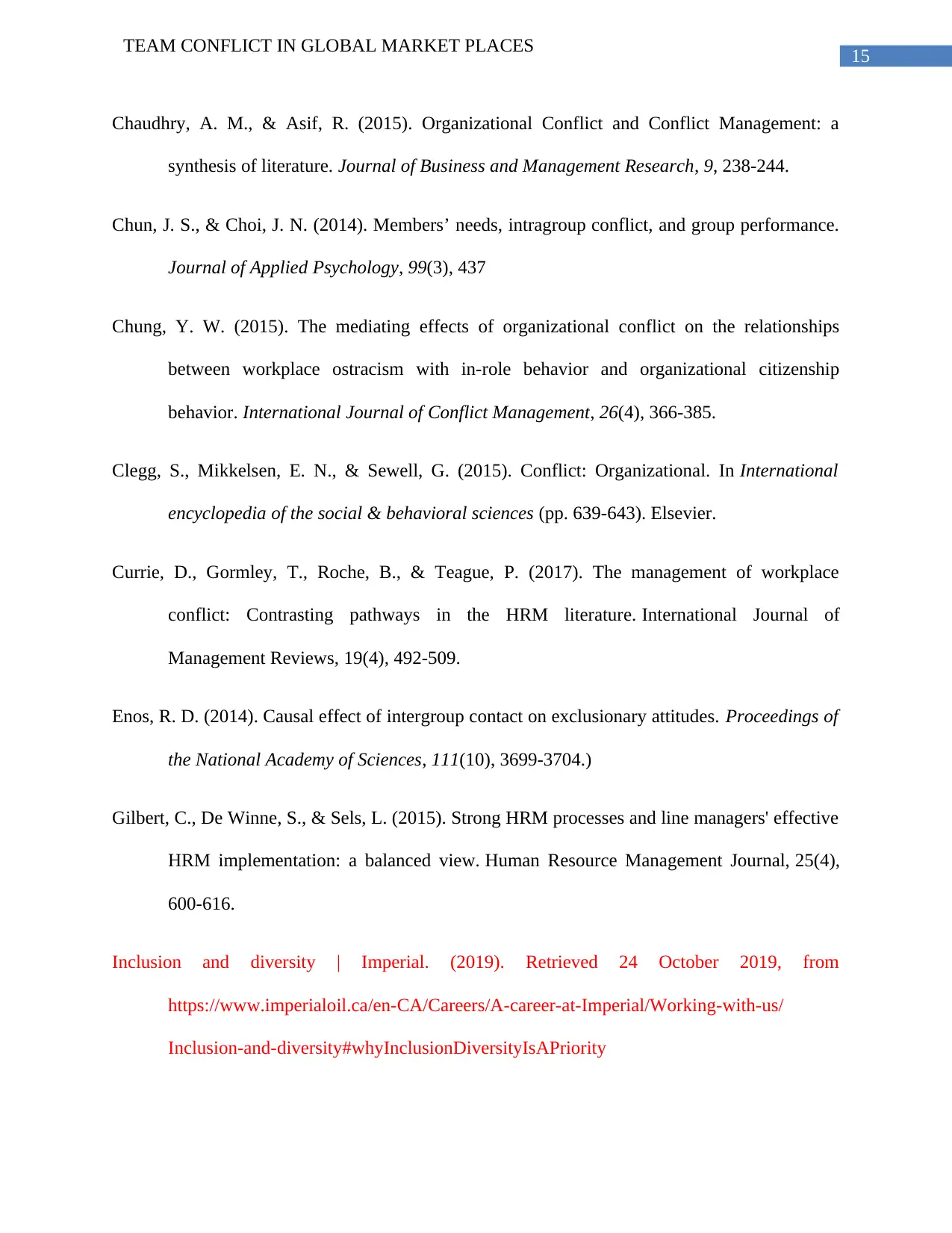
15
TEAM CONFLICT IN GLOBAL MARKET PLACES
Chaudhry, A. M., & Asif, R. (2015). Organizational Conflict and Conflict Management: a
synthesis of literature. Journal of Business and Management Research, 9, 238-244.
Chun, J. S., & Choi, J. N. (2014). Members’ needs, intragroup conflict, and group performance.
Journal of Applied Psychology, 99(3), 437
Chung, Y. W. (2015). The mediating effects of organizational conflict on the relationships
between workplace ostracism with in-role behavior and organizational citizenship
behavior. International Journal of Conflict Management, 26(4), 366-385.
Clegg, S., Mikkelsen, E. N., & Sewell, G. (2015). Conflict: Organizational. In International
encyclopedia of the social & behavioral sciences (pp. 639-643). Elsevier.
Currie, D., Gormley, T., Roche, B., & Teague, P. (2017). The management of workplace
conflict: Contrasting pathways in the HRM literature. International Journal of
Management Reviews, 19(4), 492-509.
Enos, R. D. (2014). Causal effect of intergroup contact on exclusionary attitudes. Proceedings of
the National Academy of Sciences, 111(10), 3699-3704.)
Gilbert, C., De Winne, S., & Sels, L. (2015). Strong HRM processes and line managers' effective
HRM implementation: a balanced view. Human Resource Management Journal, 25(4),
600-616.
Inclusion and diversity | Imperial. (2019). Retrieved 24 October 2019, from
https://www.imperialoil.ca/en-CA/Careers/A-career-at-Imperial/Working-with-us/
Inclusion-and-diversity#whyInclusionDiversityIsAPriority
TEAM CONFLICT IN GLOBAL MARKET PLACES
Chaudhry, A. M., & Asif, R. (2015). Organizational Conflict and Conflict Management: a
synthesis of literature. Journal of Business and Management Research, 9, 238-244.
Chun, J. S., & Choi, J. N. (2014). Members’ needs, intragroup conflict, and group performance.
Journal of Applied Psychology, 99(3), 437
Chung, Y. W. (2015). The mediating effects of organizational conflict on the relationships
between workplace ostracism with in-role behavior and organizational citizenship
behavior. International Journal of Conflict Management, 26(4), 366-385.
Clegg, S., Mikkelsen, E. N., & Sewell, G. (2015). Conflict: Organizational. In International
encyclopedia of the social & behavioral sciences (pp. 639-643). Elsevier.
Currie, D., Gormley, T., Roche, B., & Teague, P. (2017). The management of workplace
conflict: Contrasting pathways in the HRM literature. International Journal of
Management Reviews, 19(4), 492-509.
Enos, R. D. (2014). Causal effect of intergroup contact on exclusionary attitudes. Proceedings of
the National Academy of Sciences, 111(10), 3699-3704.)
Gilbert, C., De Winne, S., & Sels, L. (2015). Strong HRM processes and line managers' effective
HRM implementation: a balanced view. Human Resource Management Journal, 25(4),
600-616.
Inclusion and diversity | Imperial. (2019). Retrieved 24 October 2019, from
https://www.imperialoil.ca/en-CA/Careers/A-career-at-Imperial/Working-with-us/
Inclusion-and-diversity#whyInclusionDiversityIsAPriority
Secure Best Marks with AI Grader
Need help grading? Try our AI Grader for instant feedback on your assignments.
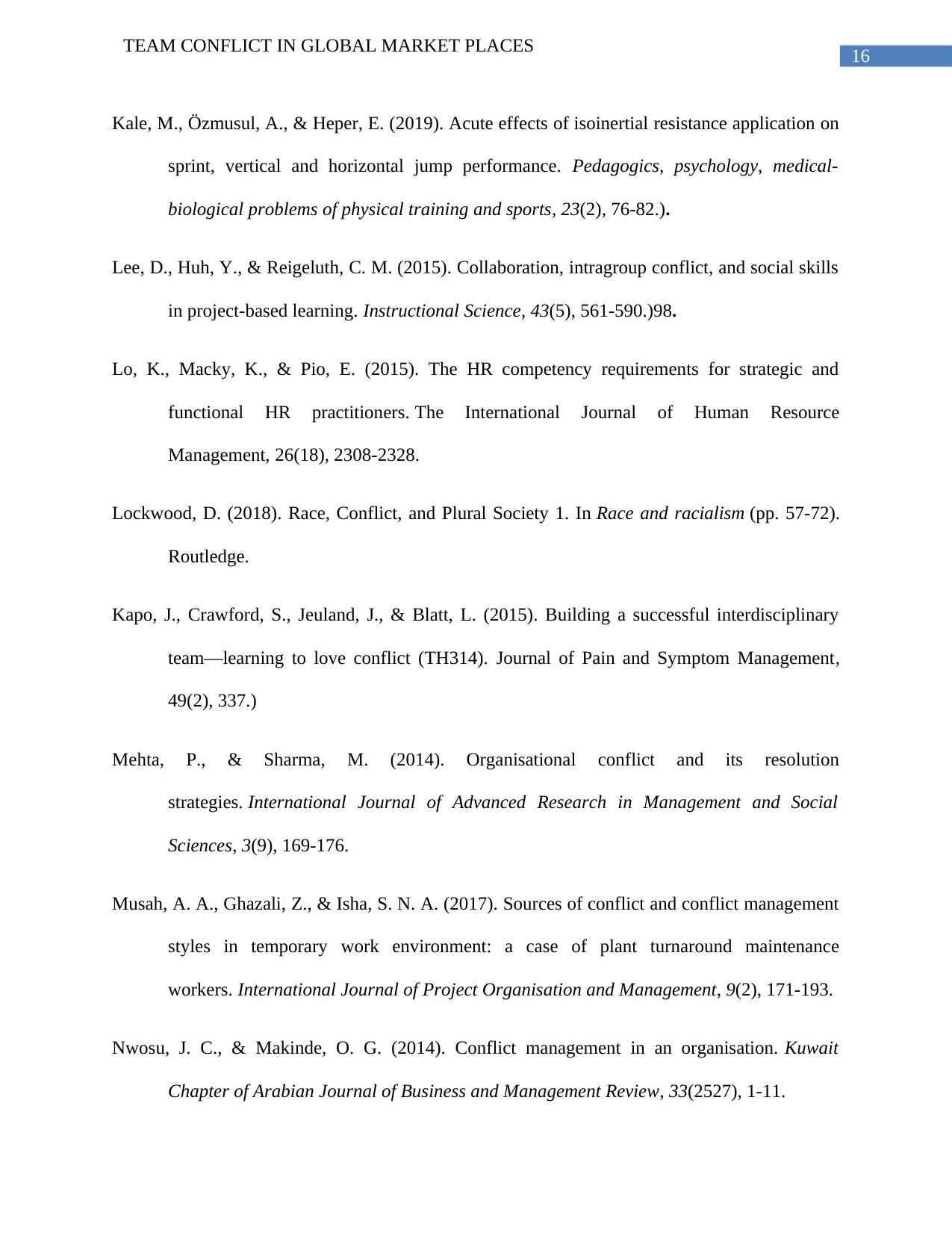
16
TEAM CONFLICT IN GLOBAL MARKET PLACES
Kale, M., Özmusul, A., & Heper, E. (2019). Acute effects of isoinertial resistance application on
sprint, vertical and horizontal jump performance. Pedagogics, psychology, medical-
biological problems of physical training and sports, 23(2), 76-82.).
Lee, D., Huh, Y., & Reigeluth, C. M. (2015). Collaboration, intragroup conflict, and social skills
in project-based learning. Instructional Science, 43(5), 561-590.)98.
Lo, K., Macky, K., & Pio, E. (2015). The HR competency requirements for strategic and
functional HR practitioners. The International Journal of Human Resource
Management, 26(18), 2308-2328.
Lockwood, D. (2018). Race, Conflict, and Plural Society 1. In Race and racialism (pp. 57-72).
Routledge.
Kapo, J., Crawford, S., Jeuland, J., & Blatt, L. (2015). Building a successful interdisciplinary
team—learning to love conflict (TH314). Journal of Pain and Symptom Management,
49(2), 337.)
Mehta, P., & Sharma, M. (2014). Organisational conflict and its resolution
strategies. International Journal of Advanced Research in Management and Social
Sciences, 3(9), 169-176.
Musah, A. A., Ghazali, Z., & Isha, S. N. A. (2017). Sources of conflict and conflict management
styles in temporary work environment: a case of plant turnaround maintenance
workers. International Journal of Project Organisation and Management, 9(2), 171-193.
Nwosu, J. C., & Makinde, O. G. (2014). Conflict management in an organisation. Kuwait
Chapter of Arabian Journal of Business and Management Review, 33(2527), 1-11.
TEAM CONFLICT IN GLOBAL MARKET PLACES
Kale, M., Özmusul, A., & Heper, E. (2019). Acute effects of isoinertial resistance application on
sprint, vertical and horizontal jump performance. Pedagogics, psychology, medical-
biological problems of physical training and sports, 23(2), 76-82.).
Lee, D., Huh, Y., & Reigeluth, C. M. (2015). Collaboration, intragroup conflict, and social skills
in project-based learning. Instructional Science, 43(5), 561-590.)98.
Lo, K., Macky, K., & Pio, E. (2015). The HR competency requirements for strategic and
functional HR practitioners. The International Journal of Human Resource
Management, 26(18), 2308-2328.
Lockwood, D. (2018). Race, Conflict, and Plural Society 1. In Race and racialism (pp. 57-72).
Routledge.
Kapo, J., Crawford, S., Jeuland, J., & Blatt, L. (2015). Building a successful interdisciplinary
team—learning to love conflict (TH314). Journal of Pain and Symptom Management,
49(2), 337.)
Mehta, P., & Sharma, M. (2014). Organisational conflict and its resolution
strategies. International Journal of Advanced Research in Management and Social
Sciences, 3(9), 169-176.
Musah, A. A., Ghazali, Z., & Isha, S. N. A. (2017). Sources of conflict and conflict management
styles in temporary work environment: a case of plant turnaround maintenance
workers. International Journal of Project Organisation and Management, 9(2), 171-193.
Nwosu, J. C., & Makinde, O. G. (2014). Conflict management in an organisation. Kuwait
Chapter of Arabian Journal of Business and Management Review, 33(2527), 1-11.
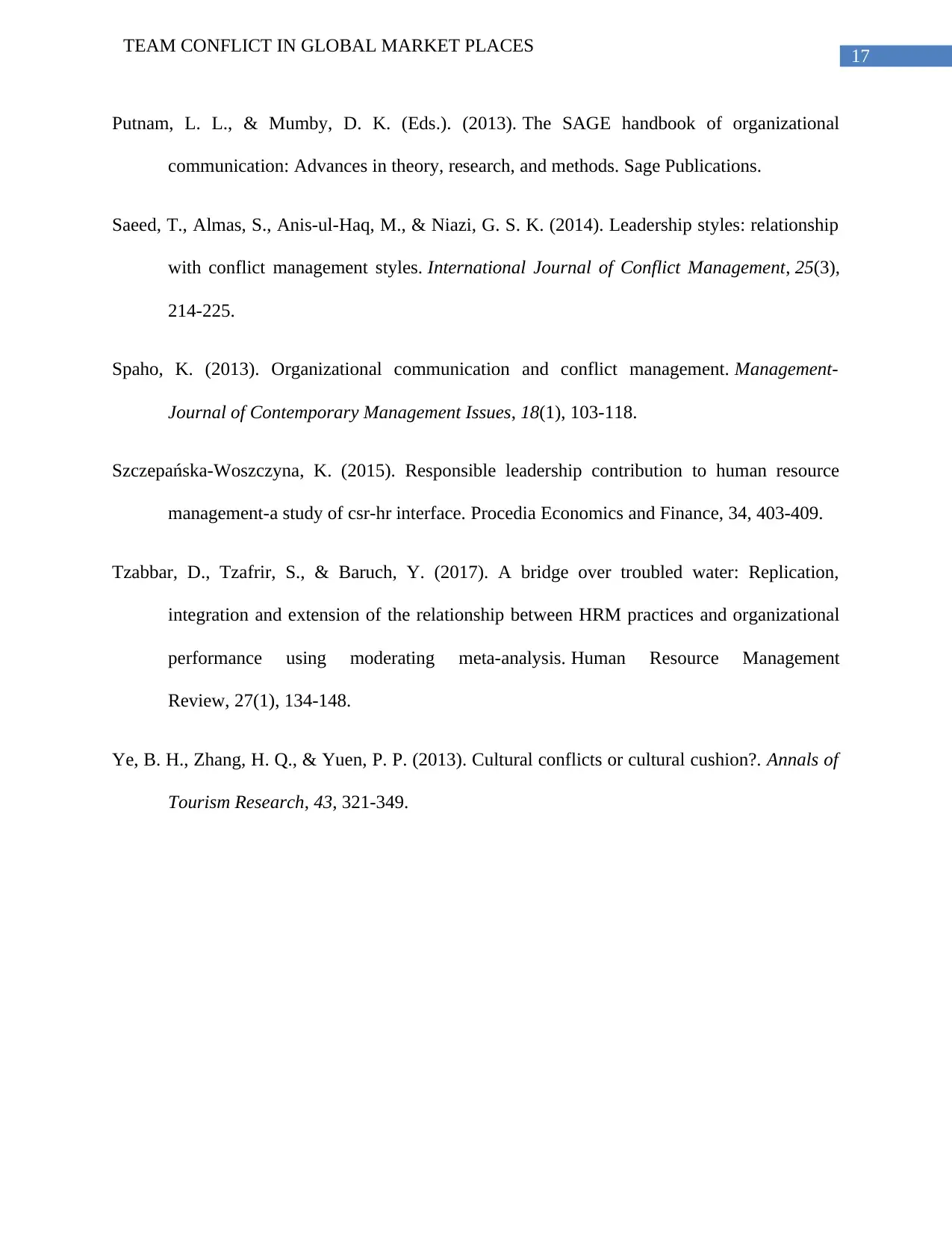
17
TEAM CONFLICT IN GLOBAL MARKET PLACES
Putnam, L. L., & Mumby, D. K. (Eds.). (2013). The SAGE handbook of organizational
communication: Advances in theory, research, and methods. Sage Publications.
Saeed, T., Almas, S., Anis-ul-Haq, M., & Niazi, G. S. K. (2014). Leadership styles: relationship
with conflict management styles. International Journal of Conflict Management, 25(3),
214-225.
Spaho, K. (2013). Organizational communication and conflict management. Management-
Journal of Contemporary Management Issues, 18(1), 103-118.
Szczepańska-Woszczyna, K. (2015). Responsible leadership contribution to human resource
management-a study of csr-hr interface. Procedia Economics and Finance, 34, 403-409.
Tzabbar, D., Tzafrir, S., & Baruch, Y. (2017). A bridge over troubled water: Replication,
integration and extension of the relationship between HRM practices and organizational
performance using moderating meta-analysis. Human Resource Management
Review, 27(1), 134-148.
Ye, B. H., Zhang, H. Q., & Yuen, P. P. (2013). Cultural conflicts or cultural cushion?. Annals of
Tourism Research, 43, 321-349.
TEAM CONFLICT IN GLOBAL MARKET PLACES
Putnam, L. L., & Mumby, D. K. (Eds.). (2013). The SAGE handbook of organizational
communication: Advances in theory, research, and methods. Sage Publications.
Saeed, T., Almas, S., Anis-ul-Haq, M., & Niazi, G. S. K. (2014). Leadership styles: relationship
with conflict management styles. International Journal of Conflict Management, 25(3),
214-225.
Spaho, K. (2013). Organizational communication and conflict management. Management-
Journal of Contemporary Management Issues, 18(1), 103-118.
Szczepańska-Woszczyna, K. (2015). Responsible leadership contribution to human resource
management-a study of csr-hr interface. Procedia Economics and Finance, 34, 403-409.
Tzabbar, D., Tzafrir, S., & Baruch, Y. (2017). A bridge over troubled water: Replication,
integration and extension of the relationship between HRM practices and organizational
performance using moderating meta-analysis. Human Resource Management
Review, 27(1), 134-148.
Ye, B. H., Zhang, H. Q., & Yuen, P. P. (2013). Cultural conflicts or cultural cushion?. Annals of
Tourism Research, 43, 321-349.
1 out of 18
Related Documents
Your All-in-One AI-Powered Toolkit for Academic Success.
+13062052269
info@desklib.com
Available 24*7 on WhatsApp / Email
![[object Object]](/_next/static/media/star-bottom.7253800d.svg)
Unlock your academic potential
© 2024 | Zucol Services PVT LTD | All rights reserved.




